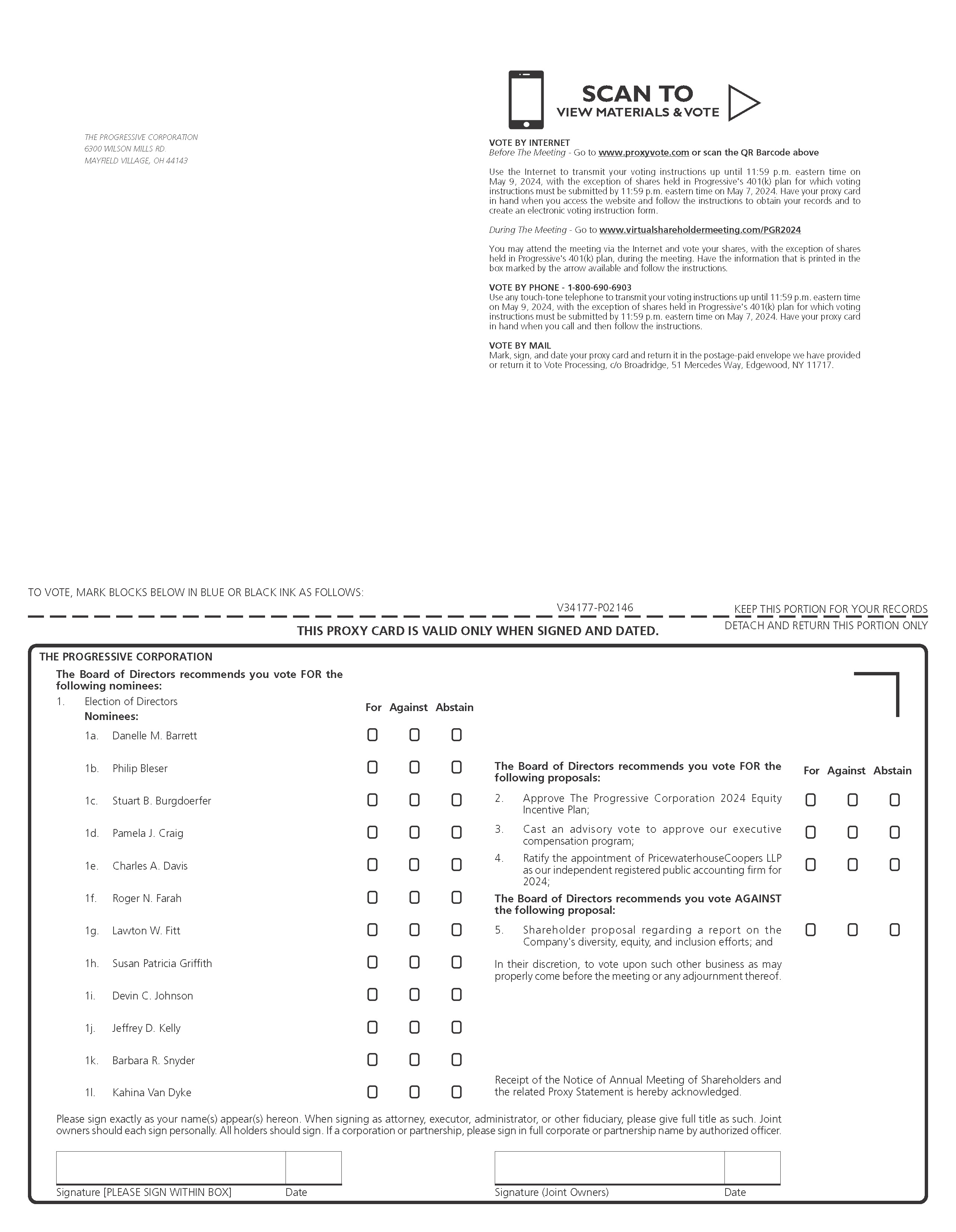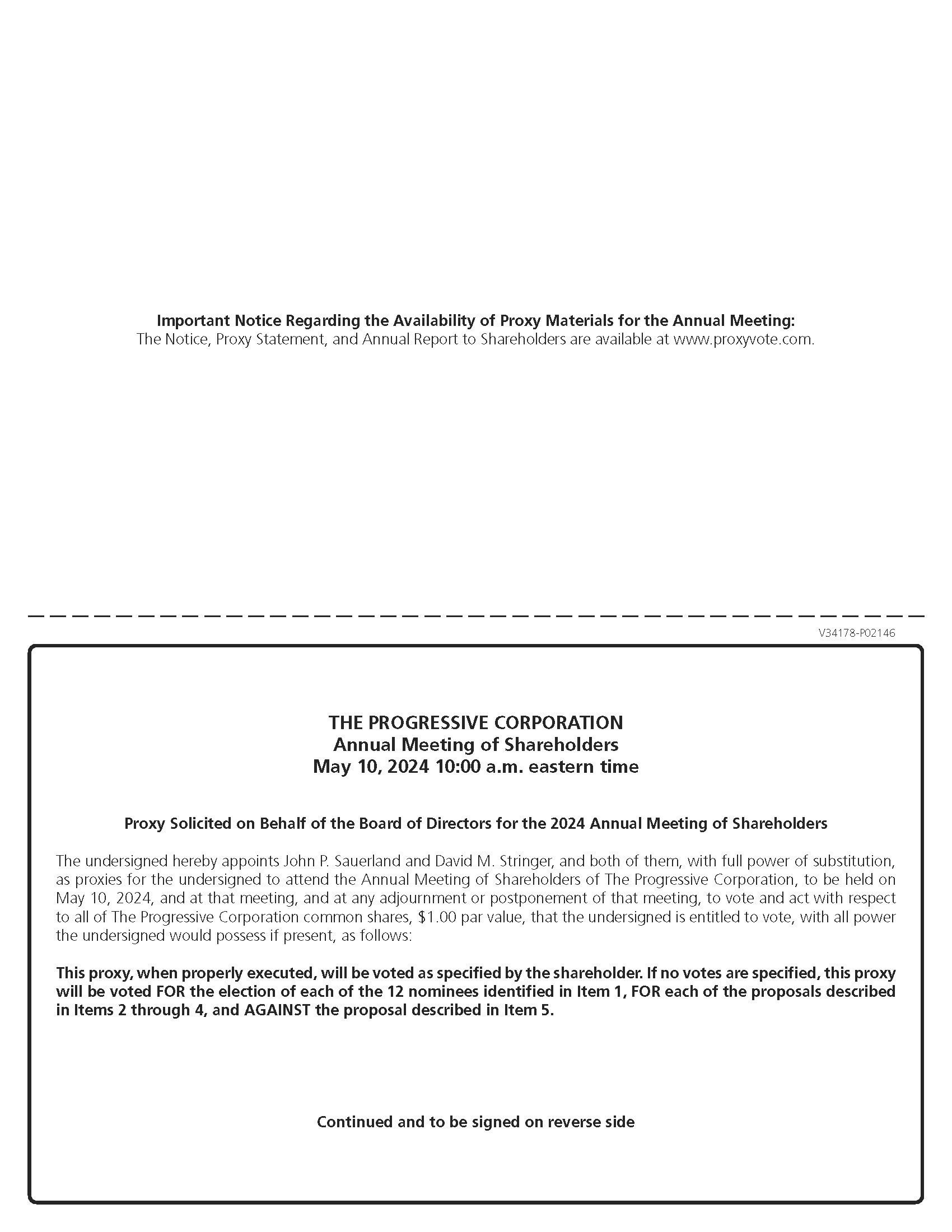
Filed by the Registrant x | ||||||||
Filed by a | ||||||||
| Check the appropriate box: | ||||||||
| o | Preliminary Proxy Statement | |||||||
| o | Confidential, for Use of the Commission Only (as permitted by Rule 14a-6(e)(2)) | |||||||
| x | Definitive Proxy Statement | |||||||
| o | Definitive Additional Materials | |||||||
| o | Soliciting Material | |||||||
| (Name of Registrant as Specified In Its Charter) | ||||||||||||||
| (Name of Person(s) Filing Proxy Statement, if other than the Registrant) | ||||||||||||||
| Payment of Filing Fee (Check | ||||||||||||||
| x | No fee | |||||||||||||
| ¨ | Fee paid previously with preliminary materials | |||||||||||||
| ¨ | Fee computed on table | |||||||||||||

E-1 | |||||
| WHETHER OR NOT YOU PLAN TO ATTEND THE | ||||||||||||||
| Item Number | Voting Matter | Board Recommendation | |||||||||
| 1 | Elect as directors the 12 nominees identified in this Proxy Statement, each to serve for a term of one year | FOR each nominee | |||||||||
| 2 | Approve The Progressive Corporation 2024 Equity Incentive Plan | FOR | |||||||||
| 3 | Cast an advisory vote to approve our executive compensation program | FOR | |||||||||
| Ratify the appointment of PricewaterhouseCoopers LLP as our independent registered public accounting firm for | FOR | ||||||||||
| 5 | Act on a shareholder proposal, if properly presented | AGAINST | |||||||||
| Net premiums written growth | 20 | % | |||
| Policies in force growth | 9 | % | |||
| Combined ratio | 94.9 | ||||
| Underwriting profit margin | 5.1 | % | |||
| Returns on average common shareholders’ equity: | |||||
| Net income | 22.9 | % | |||
| Comprehensive income | 30.0 | % | |||
| Net income | $3.9 billion | ||||
| Net income per common share | $6.58 | ||||
| Declared common shareholder dividends | $0.7 billion | ||||
| Repurchased common shares | $0.1 billion | ||||







| Effective Structure and Composition | Additional Practices and Policies | Shareholder Rights | |||||||||||||||||||||||||||
| ✔ | Independent, experienced Chairperson | ✔ | Robust director stock ownership guidelines | ✔ | Single class voting | ||||||||||||||||||||||||
| ✔ | Independent committee leadership and strong independent committee membership | ✔ | Established Board and committee risk oversight practices | ✔ | Annual election of all directors | ||||||||||||||||||||||||
| ✔ | A diverse and highly qualified Board | ✔ | Board technology/cybersecurity expertise and oversight | ✔ | Majority voting in uncontested director elections | ||||||||||||||||||||||||
| ✔ | Five new directors in the last six years (including four | ✔ | ✔ | Proxy access available | |||||||||||||||||||||||||
| ✔ | Mandatory director retirement policy (no exemptions or waivers within the past three years) | ✔ | ✔ | No poison pill | |||||||||||||||||||||||||
| ✔ | Independent directors meet regularly without management | ✔ | |||||||||||||||||||||||||||
| ✔ | Restrictions limiting the number of public company boards on which a director may serve | ✔ | Annual Board and committee evaluation process | ||||||||||||||||||||||||||
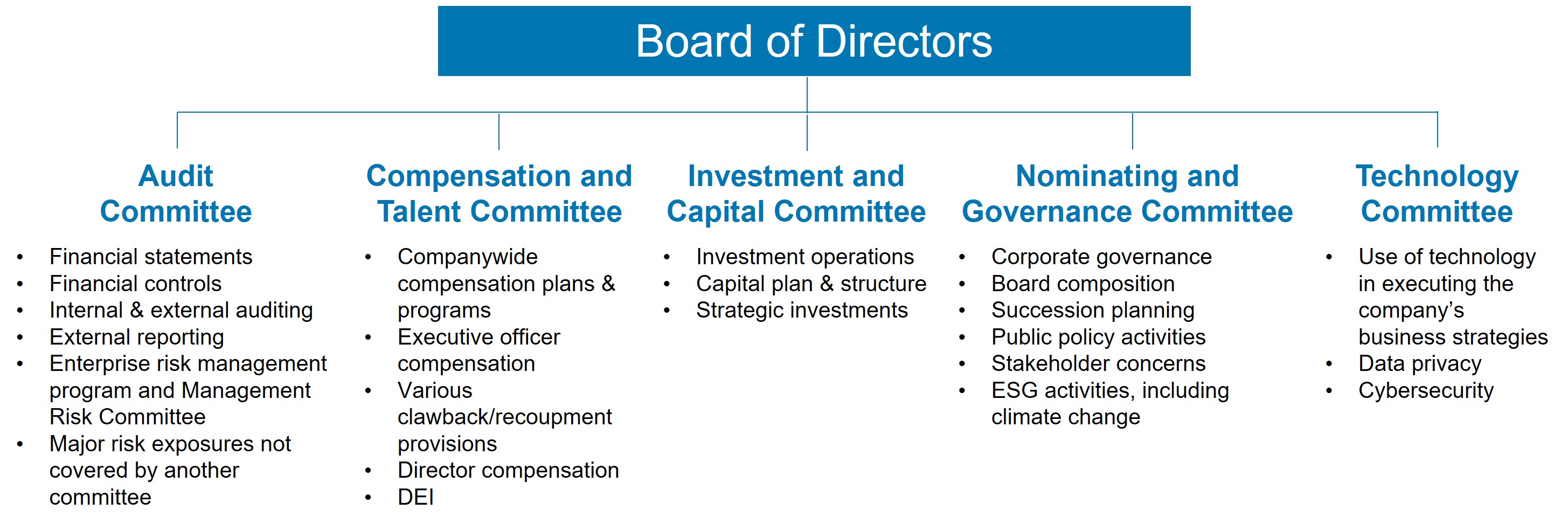
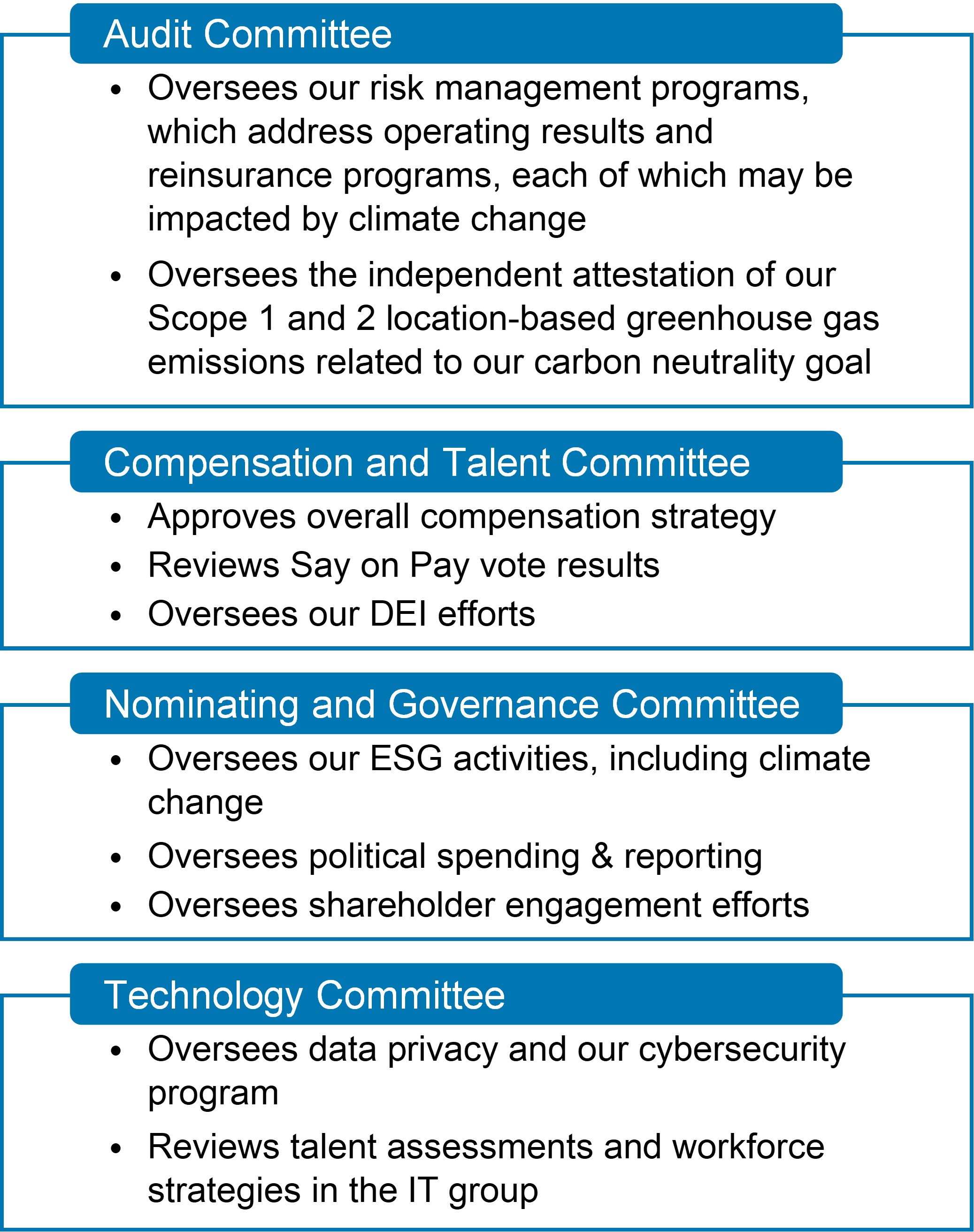

| Spotlight on Environmental Stewardship | |||||||||||
We continue to make increasing efforts to reduce carbon emissions and | operate efficiently in all aspects of our business. We report our environmental efforts to inform our stakeholders of the efforts we are making, the initiatives and steps taken, and the forward movement on our commitments. We continue to advance our environmental stewardship efforts by seeking investments in green energy usage for our facilities, exploring opportunities to shift toward a lower-emissions vehicle fleet, and reducing paper correspondence with our customers. We believe that if we can yield positive environmental results from our business operations, we can create a sustainable business in line with our Core Values. As we look forward to the future, we are excited to continue to be responsible environmental stewards. We have an aspirational goal of carbon neutrality by the end of 2025 for Scopes 1 and 2, which we believe will help set the path to net-zero in the following decade. To enhance our accountability, we engaged an independent third party to provide limited assurance on our Scope 1 and Scope 2 location-based greenhouse gas emissions reporting. | ||||||||||
| What We DO Have | |||||||||||
| ✔ | Independent Compensation and Talent Committee that establishes compensation for executive officers | ||||||||||
| ✔ | Heavy weighting of at-risk “pay for performance” compensation | ||||||||||
| ✔ | Typically below market base salary with opportunity to exceed median with strong performance | ||||||||||
| ✔ | Stock ownership guidelines | ||||||||||
| ✔ | Clawback/forfeiture provisions (including restatements and reputational harm) and a separate Dodd-Frank Clawback Policy | ||||||||||
| ✔ | DEI-related goal embedded into each executive officer’s job objectives, which factors into setting overall annual target compensation | ||||||||||
| What We DON’T Have | ||||||||
| ✘ | Employment agreements | |||||||
| ✘ | Guaranteed salary increases or bonuses | |||||||
| ✘ | Hedging/pledging of our stock | |||||||
| ✘ | “Timing” of equity awards | |||||||
| ✘ | Single-trigger change in control benefits | |||||||
| ✘ | Pension plan or supplemental retirement benefits provided to executives | |||||||
| The Board of Directors recommends that you vote FOR the election of each nominee. | ||||||||||||||


  |   |   |   |   |   |   |   |   | |||||||||||||||||||||||||||||||||
| Accounting & Finance | Corporate Governance | Highly Regulated Businesses | Insurance/ Financial Services | Investment & Capital Management | Retail/Marketing | Risk Management | Technology/Cybersecurity | ||||||||||||||||||||||||||||||||||
| Danelle M. Barrett | l | l | l | l | l | ||||||||||||||||||||||||||||||||||||
| Philip Bleser | l | l | l | l | l | l | l | l | |||||||||||||||||||||||||||||||||
| Stuart B. Burgdoerfer | l | l | l | l | l | l | |||||||||||||||||||||||||||||||||||
| Pamela J. Craig | l | l | l | l | l | l | |||||||||||||||||||||||||||||||||||
| Charles A. Davis | l | l | l | l | l | l | l | ||||||||||||||||||||||||||||||||||
| Roger N. Farah | l | ||||||||||||||||||||||||||||||||||||||||
| l | l | l | l | ||||||||||||||||||||||||||||||||||||||
| Lawton W. Fitt | l | l | l | l | l | l | l | ||||||||||||||||||||||||||||||||||
| Susan Patricia Griffith | l | l | l | l | l | l | |||||||||||||||||||||||||||||||||||
| Devin C. Johnson | l | l | l | l | |||||||||||||||||||||||||||||||||||||
| Jeffrey D. Kelly | l | l | l | l | l | l | l | ||||||||||||||||||||||||||||||||||
| Barbara R. Snyder | l | l | l | l | l | ||||||||||||||||||||||||||||||||||||
| Kahina Van Dyke | l | l | l | l | l | ||||||||||||||||||||||||||||||||||||
| Name (Age) | Principal Occupation, Business Experience, and Qualifications | Other Directorships | ||||||
| Danelle M. Barrett (56) Director since: 2023 | U.S. Navy, Rear Admiral, Retired; Cybersecurity Division Director and Deputy Chief Information Officer (military) Prior to retiring, Rear Admiral Barrett served in leadership positions with the U.S. Navy for 30 years. She most recently served as the Navy Cybersecurity Division Director and Deputy Chief Information Officer on the Chief of Naval Operations staff from 2017 to 2019. In this role, she led the U.S. Navy’s strategic development and execution of digital and cybersecurity efforts, including key enterprise information technology modernization improvements to enhance warfighting and business operations. Rear Admiral Barrett also held several prior leadership positions, including Director of Current Operations at the U.S. Cyber Command and the Chief of Staff at the Navy Information Forces Command. She received her commission as an officer from the U.S. Naval Reserve Officer Training Corps. She has several advanced degrees in national security strategic studies, information management, and human capital management, among others. In addition to her current and past service as a director of two public companies, including serving as a member of their compensation and governance committees, Rear Admiral Barrett brings to the Board extensive leadership and operational experiences in complex cybersecurity matters, digital modernization and innovation, information technology systems, technology risk management, and strategic assessment, planning, and implementation. | Current ShoulderUp Technology Acquisition Corp Former KVH Industries, Inc. | ||||||
 | ||||||||
Key Skills:  Corporate Governance Corporate Governance  Highly Regulated Businesses Highly Regulated Businesses  Leadership/Culture/DEI Leadership/Culture/DEI  Risk Management Risk Management Technology/Cybersecurity Technology/Cybersecurity | ||||||||
| Name (Age) | Principal Occupation, Business Experience, and Qualifications | Other Directorships | ||||||
| Philip Bleser (69) Director since: 2017 | Retired; Chairman of Global Corporate Banking, JPMorgan Chase & Co., New York, New York (financial services) Prior to retiring in 2016, Mr. Bleser served on the executive leadership team at JPMorgan Chase, In addition to these financial and operational roles, Mr. Bleser has earned a climate leadership certificate, enhancing the Board’s oversight of climate risks and sustainable growth strategies. | Current None Former Francesca’s Holding Corp. | ||||||
  | ||||||||
Key Skills:   Accounting & Finance Accounting & Finance   Corporate Governance Corporate Governance Highly Regulated Businesses Highly Regulated Businesses   Insurance/Financial Services Insurance/Financial Services  Investment & Capital Management Investment & Capital Management   Leadership/Culture/DEI Leadership/Culture/DEI  Retail/Marketing Retail/Marketing   Risk Management Risk Management | ||||||||
| Stuart B. Burgdoerfer (60) Director since: 2009 | Retired; Executive Vice President and Chief Financial Officer, L Brands, Inc., Columbus, Ohio (retailing) Mr. | Current None Former None | ||||||
  | ||||||||
Key Skills:   Accounting & Finance Accounting & Finance   Corporate Governance Corporate Governance  Investment & Capital Management Investment & Capital Management   Leadership/Culture/DEI Leadership/Culture/DEI  Retail/Marketing Retail/Marketing   Risk Management Risk Management | ||||||||
| Name (Age) | Principal Occupation, Business Experience, and Qualifications | Other Directorships | ||||||
| Pamela J. Craig (67) Director since: 2018 | Ms. Craig is the former Chief Financial Officer of the global professional services firm, Accenture PLC. Ms. Craig worked at Accenture for 34 years in a variety of consulting and executive roles, where she developed extensive finance, capital management, operational, enterprise risk management, and technology expertise, as well as leadership experience in the context of a large, growth-oriented organization. In addition, her current and past service as a director of Progressive and other | Current Merck & Co., Inc. Corning Incorporated Former 3M Company | ||||||
  | ||||||||
Key Skills:   Accounting & Finance Accounting & Finance   Corporate Governance Corporate Governance  Investment & Capital Management Investment & Capital Management   Leadership/Culture/DEI Leadership/Culture/DEI  Risk Management Risk Management   Technology/Cybersecurity Technology/Cybersecurity | ||||||||
Charles A. Davis Director since: 1996 | Chief Executive Officer, Stone Point Capital LLC, Greenwich, Connecticut (private equity investing) Mr. Davis has broad financial, investment, and capital management expertise developed through his work as a partner at Goldman Sachs Group, investment management experience at MMC Capital, Inc., and as Chief Executive Officer of Stone Point Capital LLC. Mr. Davis has extensive knowledge of Progressive’s business and history, which he has gained through his service as a director of the company since 1996. | Current AXIS Capital Holdings Limited Former The Hershey Company | ||||||
 | ||||||||
Key Skills:   Accounting & Finance Accounting & Finance   Corporate Governance Corporate Governance Highly Regulated Businesses Highly Regulated Businesses   Insurance/Financial Services Insurance/Financial Services  Investment & Capital Management Investment & Capital Management   Leadership/Culture/DEI Leadership/Culture/DEI  Risk Management Risk Management | ||||||||
| Name (Age) | Principal Occupation, Business Experience, and Qualifications | Other Directorships | ||||||
| Roger N. Farah (71) Director since: 2008 | Retired; Executive Director, Tory Burch LLC, New York, New York (retailing) Mr. Farah | Current CVS Health Corporation Former Metro Bank PLC Tiffany & Co. | ||||||
  | ||||||||
Key Skills:   Accounting & Finance Accounting & Finance   Corporate Governance Corporate Governance Leadership/Culture/DEI Leadership/Culture/DEI  Retail/Marketing Retail/Marketing    Risk Management Risk Management | ||||||||
| Lawton W. Fitt (70) Director since: 2009 | Chairperson of the Board, The Progressive Corporation, Mayfield Village, Ohio since May 2018; Lead Independent Director, Progressive, Ms. Fitt brings a strong financial and corporate governance background to her service as Chairperson of our public companies. | Current Ciena Corporation The Carlyle Group Inc. Former Micro Focus International plc | ||||||
 | ||||||||
Key Skills:   Accounting & Finance Accounting & Finance   Corporate Governance Corporate Governance Highly Regulated Businesses Highly Regulated Businesses   Insurance/Financial Services Insurance/Financial Services  Investment & Capital Management Investment & Capital Management   Leadership/Culture/DEI Leadership/Culture/DEI  Risk Management Risk Management | ||||||||
| Name (Age) | Principal Occupation, Business Experience, and Qualifications | Other Directorships | ||||||
| Susan Patricia Griffith (59) Director since: 2016 | President and Chief Executive Officer, The Progressive Corporation, Mayfield Village, Ohio Mrs. Griffith has been with the company since 1988 and has held a series of executive leadership positions, including Chief Executive Officer (since 2016), Chief Human Resource Officer, Claims Group President (in charge of the entire Claims organization), President of Customer Operations (overseeing the contact center (sales and delivery), customer experience, systems experience, and workforce management groups), and Personal Lines Chief Operating Officer, where she oversaw the Personal Lines, Claims, and Customer Relationship Management groups. Mrs. Griffith’s intimate knowledge of | Current FedEx Corporation None | ||||||
  | ||||||||
Key Skills:   Corporate Governance Corporate Governance  Highly Regulated Businesses Highly Regulated Businesses   Insurance/Financial Services Insurance/Financial Services   Leadership/Culture/DEI Leadership/Culture/DEI  Retail/Marketing Retail/Marketing   Risk Management Risk Management | ||||||||
| Devin C. Johnson (50) Director since: 2020 | Mr. Johnson | Current None Former None | ||||||
  | ||||||||
Key Skills:   Accounting & Finance Accounting & Finance   Leadership/Culture/DEI Leadership/Culture/DEI  Retail/Marketing Retail/Marketing   Technology/Cybersecurity Technology/Cybersecurity | ||||||||
| Name (Age) | Principal Occupation, Business Experience, and Qualifications | Other Directorships | ||||||
| Jeffrey D. Kelly (70) Director since: 2012 Prior service: 2000-2009 | Retired; Chief Operating Officer and Chief Financial Officer, RenaissanceRe Holdings Ltd., Pembroke, Bermuda (reinsurance services) Mr. Kelly brings a strong history of executive management, investment management, capital markets, financial, and operational | Current None Former None | ||||||
  | ||||||||
Key Skills:   Accounting & Finance Accounting & Finance   Corporate Governance Corporate Governance Highly Regulated Businesses Highly Regulated Businesses   Insurance/Financial Services Insurance/Financial Services  Investment & Capital Management Investment & Capital Management   Leadership/Culture/DEI Leadership/Culture/DEI  Risk Management Risk Management | ||||||||
| Barbara R. Snyder (68) Director since: 2014 | President, The Association of American Universities (higher education) since October 2020; President, Case Western Reserve University, Cleveland, Ohio, prior to October 2020 Ms. Snyder has extensive leadership experience as the President of | Current KeyCorp Former None | ||||||
  | ||||||||
Key Skills:   Highly Regulated Businesses Highly Regulated Businesses   Insurance/Financial Services Insurance/Financial Services    Leadership/Culture/DEI Leadership/Culture/DEI  Risk Management Risk Management   Technology/Cybersecurity Technology/Cybersecurity | ||||||||
 | ||||||||
     | ||||||||
| Name (Age) | Principal Occupation, Business Experience, and Qualifications | Other Directorships | ||||||
| Kahina Van Dyke (52) Director since: 2018 | Operating Partner, Advent International (private equity) since October 2023; Global Head, Digital Channels and Client Data Analytics, Standard Chartered PLC, London, England (international banking) Ms. Van Dyke is | Current None Former None | ||||||
  | ||||||||
Key Skills:   Insurance/Financial Services Insurance/Financial Services   Investment & Capital Management Investment & Capital Management   Leadership/Culture/DEI Leadership/Culture/DEI  Retail/Marketing Retail/Marketing  Technology/Cybersecurity Technology/Cybersecurity | ||||||||
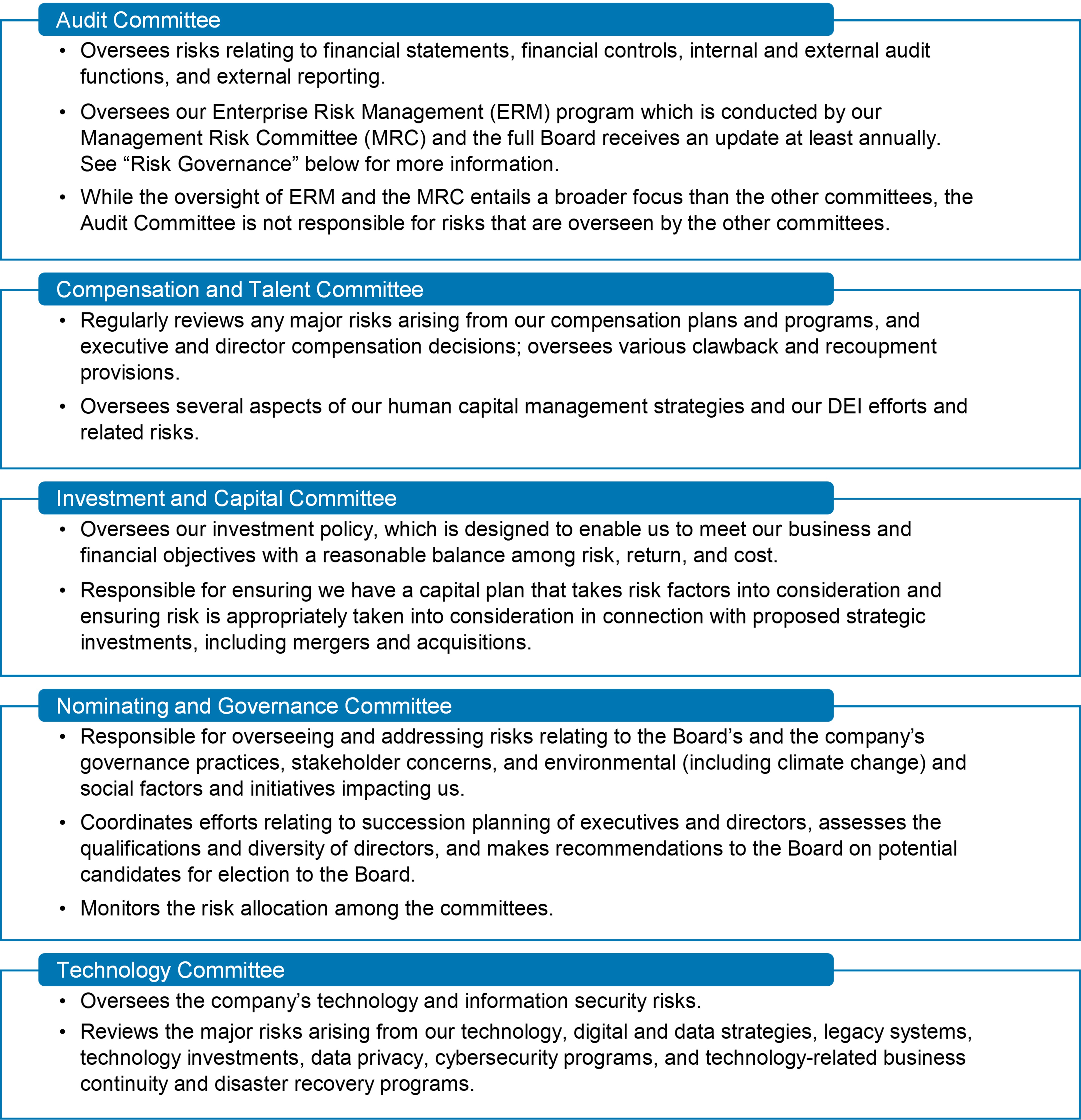
| Insurance | Risks associated with assuming, or indemnifying for, the losses or liabilities incurred by policyholders | ||||
| Operating | Risks stemming from external or internal events or circumstances that directly or indirectly may affect our insurance operations | ||||
| Market | Risks that may cause changes in the value of assets held in our investment portfolios | ||||
| Liquidity | Risk that our financial condition will be adversely affected by the inability to meet our short-term cash, collateral, or other financial obligations | ||||
| Credit and Other Financial | Risks that the other party to a transaction will fail to perform according to the terms of a contract, or that we will be unable to satisfy our obligations when due or obtain capital when necessary | ||||
| Spotlight on Climate Change Risk Management | ||
| As a property-casualty insurance company that operates our businesses throughout the United States, our success depends on our ability to underwrite and price risk accurately, which is subject to a number of risks, including those related to changes in the frequency, severity, duration, geographic location, and scope of severe weather events, which may be becoming more severe and less predictable as a result of climate change. | ||
| Our Nominating and Governance Committee oversees ESG matters, including climate change, on behalf of the Board. Additionally, the Audit Committee oversees our ERM program and, as part of that oversight, is kept apprised of certain operational risks such as climate change and our reinsurance programs. Our MRC coordinates our ERM program. In the MRC’s annual risk assessment process, we attempt to evaluate the longer-term effects of climate change and attempt to evaluate the impact on capital, pricing, our customers, and investments. | ||
| Spotlight on Cybersecurity Risk Management | ||
| Our overall efforts to safeguard the systems and confidential information critical to our operations include preventative and detective internal processes, technological defenses, and other controls designed to provide multiple layers of security protection. This integrated approach to protect data and systems is also built into the company’s project management, development, and operations. | ||
| Our Technology Committee oversees cybersecurity risk on behalf of the Board. Our Chief Security Officer (CSO) is ultimately responsible for cybersecurity at Progressive, with management oversight of the prevention, detection, mitigation, and remediation of cybersecurity incidents. The CSO reports directly to the Chief Financial Officer and provides regular cybersecurity updates to our CEO, other members of the executive team, and the Technology Committee. Our CSO is also a member of our MRC, which leads our ERM program, which results in cybersecurity risks remaining a focus of our overall risk management process. | ||
| Name | Audit | Compensation and Talent | Investment and Capital | Nominating and Governance | Technology | Executive | ||||||||||||||||||||||||||||
| ü | ||||||||||||||||||||||||||||||||||
| Philip Bleser | ü* | ü | ||||||||||||||||||||||||||||||||
| Stuart B. Burgdoerfer | ü | |||||||||||||||||||||||||||||||||
| Pamela J. Craig | ü | C | ||||||||||||||||||||||||||||||||
| Charles A. Davis | C | |||||||||||||||||||||||||||||||||
| Roger N. Farah | C | ü | ü | |||||||||||||||||||||||||||||||
| Lawton W. Fitt | ü | C | ü | |||||||||||||||||||||||||||||||
| Susan Patricia Griffith | C | |||||||||||||||||||||||||||||||||
Devin C. Johnson | ü | |||||||||||||||||||||||||||||||||
| Jeffrey D. Kelly | ü* | |||||||||||||||||||||||||||||||||
| Barbara R. Snyder | ü | |||||||||||||||||||||||||||||||||
| Kahina Van Dyke | ü | ü | ||||||||||||||||||||||||||||||||
 |  |  | ||||||||||||
| Stuart B. Burgdoerfer | Philip Bleser | Jeffrey D. Kelly | ||||||||||||
| Chair | ||||||||||||||
| Meetings Held in 2023 | Primary Responsibilities | ||||||||||
| 10 | •Ensuring that the organizational structure, policies, controls, and systems are in place to monitor and accurately report performance. •Monitoring the integrity of our financial statements, our financial reporting processes, internal control over financial reporting, and the public release of financial information. •Overseeing our compliance and ethics and risk management programs. •Confirming the independence of, and the selection, appointment, compensation, retention, and oversight of the work of, our independent registered public accounting firms. •Providing an independent channel to receive appropriate communications from employees, shareholders, auditors, legal counsel, bankers, consultants, and other interested parties. Please see “Item 1: Election of Directors – Director Nominee Information” for disclosure of each member’s relevant experience qualifying such member as an Audit Committee Financial Expert. See also the “Report of the Audit Committee,” “Item 4: Proposal to Ratify the Appointment of PricewaterhouseCoopers LLP as Our Independent Registered Public Accounting Firm for 2024,” and “Other Independent Public Accounting Firm Information” for additional related information. | ||||||||||
| Independence | |||||||||||
| The Board has determined that all members are independent (including the additional requirements for audit committee members). | |||||||||||
| Financial Literacy/Audit Committee Financial Expert | |||||||||||
| The Board has determined that all members are financially literate and are each an Audit Committee Financial Expert, as that term is defined in the applicable SEC rules. | |||||||||||
 |  |  | ||||||||||||
| Roger N. Farah | Pamela J. Craig | Barbara R. Snyder | ||||||||||||
| Chair | ||||||||||||||
| Meetings Held in 2023 | Primary Responsibilities | ||||||||||
| 7 | •Making final determinations regarding executive compensation, including salary, equity-based awards, and annual cash incentive targets, and related performance goals, formulae, and procedures. •Approving (or in certain circumstances, recommending to the full Board for approval) the terms of the various compensation and benefit plans in which executive officers and other employees may participate. •Administering our Dodd-Frank Clawback Policy and, separately from such policy, overseeing any additional compensation recoupment, recovery, or similar provisions in our compensation and benefit plans. •Reporting to the full Board on executive compensation, DEI, and several aspects of our human capital management efforts. The committee’s determinations regarding incentive compensation for executive officers (for example, performance criteria and standards relating to Gainshare, our annual cash incentive program) generally also apply to incentive plans covering most other employees. Under this program, executives and non-executives alike are motivated to achieve the same performance objectives. The committee has delegated to management the authority to implement such plans, and make other compensation-related decisions (such as salary and equity-based awards), for employees other than executive officers. Please see “Compensation Discussion and Analysis” and “Compensation Committee Report” for additional related information. | ||||||||||
| Resolutions Adopted by Written Action | |||||||||||
| 2 | |||||||||||
| Independence | |||||||||||
| The Board has determined that all members are independent (including the additional requirements for compensation committee members). | |||||||||||
 |  |  | ||||||||||||
| Charles A. Davis | Lawton W. Fitt | Kahina Van Dyke | ||||||||||||
| Chair | ||||||||||||||
| Meetings Held in 2023 | Primary Responsibilities | ||||||||||
| 5 | •Monitoring whether the company has adopted and adheres to rational and prudent investment and capital management policies. •Monitoring whether management’s investment and capital management actions are consistent with our investment policy, financial objectives, and business goals. •Monitoring our compliance with legal and regulatory requirements and internal guidelines pertaining to investment and capital management. •Monitoring the competence and performance of the company’s internal and external money managers. •Monitoring the compensation of external money managers. •Monitoring the company’s Strategy Group and proposed strategic investments, including mergers and acquisitions. The committee does not make operating decisions about money manager selection or compensation, asset allocation, market timing, sector rotation, or security selection, which are the responsibilities of management. The full Board must approve significant changes to the company’s capital structure, dividend policy, or portfolio asset allocation, as well as significant strategic investments. | ||||||||||
| Independence | |||||||||||
| The Board has determined that all members are independent. | |||||||||||
 |  |  | ||||||||||||
| Lawton W. Fitt | Philip Bleser | Roger N. Farah | ||||||||||||
| Chair | ||||||||||||||
| Meetings Held in 2023 | Primary Responsibilities | ||||||||||
| 5 | •Considering the qualifications of individuals who are proposed as possible nominees for election to the Board and making recommendations to the Board with respect to such potential candidates. •Overseeing the process for evaluating director, committee, and board performance. •Monitoring corporate governance matters affecting the Board and the company. •Regularly reviewing our Corporate Governance Guidelines to ensure that they continue to correspond to, and support, the Board’s governance philosophy and considers, where appropriate, recommending to the Board for approval, changes to the Corporate Governance Guidelines based on suggestions from its members, other Board members, or management. •Overseeing environmental, including climate change, and social factors and initiatives impacting us. At each of its meetings during 2023, the committee received updates from the company’s management concerning ESG matters. The committee welcomes input from shareholders regarding potential director nominees. Shareholders can recommend a candidate for consideration by the committee by following the procedures described under “Other Matters – Procedures for Recommendations and Nominations of Directors and Shareholder Proposals.” | ||||||||||
| Independence | |||||||||||
| The Board has determined that all members are independent. | |||||||||||
 |  |  |  |  | ||||||||||
| Pamela J. Craig | Danelle M. Barrett | Stuart B. Burgdoerfer | Devin C. Johnson | Kahina Van Dyke | ||||||||||
| Chair | ||||||||||||||
| Meetings Held in 2023 | Primary Responsibilities | ||||||||||
| 5 | •Overseeing the use of technology in executing our business strategies, including: •Technology strategies (including digital strategies) and technology investments, •Cybersecurity programs, and •Operational performance, technology-related business continuity, and disaster recovery efforts. •Monitoring related industry trends. At each meeting, the committee received updates from the company’s Chief Information Officer and Chief Security Officer, among other members of management, on technology investments, IT programs and operations, and the company’s information security programs, matters, and efforts. | ||||||||||
| Independence | |||||||||||
| The Board has determined that all members are independent. | |||||||||||
REPORT OF THE AUDIT COMMITTEE The following Report of the Audit Committee does not constitute soliciting material and should not be deemed filed or incorporated by reference into any other Progressive filing under the Securities Act of 1933 or the Securities Exchange Act of 1934, except to the extent Progressive specifically incorporates this Report by reference therein. The Audit Committee of the Board of Directors consists of the three directors named below, each of whom the Board has determined meets the applicable independence and experience requirements of the New York Stock Exchange and the Securities and Exchange Commission (SEC). In addition, the Board has determined that each of The Audit Committee is responsible, on behalf of the Board, for ensuring that the organizational structure, policies, controls, and systems are in place to monitor and accurately report the company’s performance. The committee monitors the integrity of the company’s financial statements, its financial reporting processes, its system of internal control over financial reporting, and the public release of financial information. In addition, the committee oversees the company’s compliance and ethics and enterprise risk management programs. During The committee also is directly responsible for the appointment, compensation, retention, and oversight of the company’s independent registered public accounting firm and for reviewing that firm’s independence. For In supervising the work of PwC on the The committee’s role relating to the financial statements is one of oversight. The company’s management has the primary responsibility for the financial statements and the reporting process, including the system of internal control over financial reporting. Management reports to the committee on financial, accounting, and operational developments that may impact the financial statements, and on issues relating to the company’s internal controls, among other matters. The committee also oversees the work of PwC and the company’s internal audit staff. During Notwithstanding the committee’s oversight efforts, and the work performed by the company’s internal audit staff, PwC alone is responsible for expressing its opinion on the conformity of the company’s consolidated year-end financial statements with accounting principles generally accepted in the United States of America and its assessment of the effectiveness of the company’s internal control over financial reporting. In fulfilling its oversight responsibilities, the committee reviewed and discussed with management the company’s audited consolidated financial statements for the year ended December 31, Based on the reviews and discussions referred to above, the committee recommended to the Board of Directors that the audited consolidated financial statements be included in The Progressive Corporation’s Annual Report on Form 10-K for the year ended December 31, The committee operates under a written charter, the terms of which are reviewed annually by the committee. The current charter, as approved by the Board, is posted on the company’s website at progressive.com/governance. AUDIT COMMITTEE Stuart B. Burgdoerfer,Chair Philip Bleser Jeffrey D. Kelly | ||
| Name and Address of Beneficial Owner | Amount and Nature of Beneficial Ownership | Percent of Class | ||||||||||
The Vanguard Group, Inc. 100 Vanguard Blvd. Malvern, PA 19355 | 8.8 | % | ||||||||||
BlackRock, Inc. and subsidiaries New York, NY | 8.0 | % | ||||||||||
| Name | Name | Total Common Shares Beneficially Owned1 | Percent of Class2 | Units Equivalent to Common Shares3 | Total Interest in Common Shares and Unit Equivalents | ||||||||||||||||||||
| John A. Barbagallo | 96,067 | * | 16,976 | 113,043 | |||||||||||||||||||||
| Name | |||||||||||||||||||||||||
| Name | |||||||||||||||||||||||||
| Karen B. Bailo | |||||||||||||||||||||||||
| Karen B. Bailo | |||||||||||||||||||||||||
| Karen B. Bailo | |||||||||||||||||||||||||
| Danelle M. Barrett | |||||||||||||||||||||||||
| Danelle M. Barrett | |||||||||||||||||||||||||
| Danelle M. Barrett | |||||||||||||||||||||||||
| Philip Bleser | |||||||||||||||||||||||||
| Philip Bleser | |||||||||||||||||||||||||
| Philip Bleser | Philip Bleser | 16,134 | * | 1,134 | 17,268 | ||||||||||||||||||||
| Stuart B. Burgdoerfer | Stuart B. Burgdoerfer | 22,605 | * | — | 22,605 | ||||||||||||||||||||
| Stuart B. Burgdoerfer | |||||||||||||||||||||||||
| Stuart B. Burgdoerfer | |||||||||||||||||||||||||
| Patrick K. Callahan | |||||||||||||||||||||||||
| Patrick K. Callahan | |||||||||||||||||||||||||
| Patrick K. Callahan | Patrick K. Callahan | 13,148 | * | 112,684 | 125,832 | ||||||||||||||||||||
| Pamela J. Craig | Pamela J. Craig | 7,016 | * | 114 | 7,130 | ||||||||||||||||||||
| Pamela J. Craig | |||||||||||||||||||||||||
| Pamela J. Craig | |||||||||||||||||||||||||
| Charles A. Davis | |||||||||||||||||||||||||
| Charles A. Davis | |||||||||||||||||||||||||
| Charles A. Davis | Charles A. Davis | 337,505 | * | 12,199 | 349,704 | ||||||||||||||||||||
| Roger N. Farah | Roger N. Farah | 107,260 | * | 27,963 | 135,223 | ||||||||||||||||||||
| Roger N. Farah | |||||||||||||||||||||||||
| Roger N. Farah | |||||||||||||||||||||||||
| Lawton W. Fitt | |||||||||||||||||||||||||
| Lawton W. Fitt | |||||||||||||||||||||||||
| Lawton W. Fitt | Lawton W. Fitt | 102,151 | * | 20,250 | 122,401 | ||||||||||||||||||||
| Susan Patricia Griffith | Susan Patricia Griffith | 565,352 | * | 123,641 | 688,993 | ||||||||||||||||||||
| Susan Patricia Griffith | |||||||||||||||||||||||||
| Susan Patricia Griffith | |||||||||||||||||||||||||
| Devin C. Johnson | |||||||||||||||||||||||||
| Devin C. Johnson | |||||||||||||||||||||||||
| Devin C. Johnson | Devin C. Johnson | 983 | * | — | 983 | ||||||||||||||||||||
| Jeffrey D. Kelly | Jeffrey D. Kelly | 67,037 | * | — | 67,037 | ||||||||||||||||||||
| Patrick H. Nettles, Ph.D. | 125,430 | * | 40,084 | 165,514 | |||||||||||||||||||||
| Jeffrey D. Kelly | |||||||||||||||||||||||||
| Jeffrey D. Kelly | |||||||||||||||||||||||||
| John Murphy | |||||||||||||||||||||||||
| John Murphy | |||||||||||||||||||||||||
| John Murphy | |||||||||||||||||||||||||
| John P. Sauerland | John P. Sauerland | 420,725 | * | 54,917 | 475,642 | ||||||||||||||||||||
| Michael D. Sieger | 46,433 | * | 29,749 | 76,182 | |||||||||||||||||||||
| John P. Sauerland | |||||||||||||||||||||||||
| John P. Sauerland | |||||||||||||||||||||||||
| Barbara R. Snyder | Barbara R. Snyder | 29,944 | * | 14,640 | 44,584 | ||||||||||||||||||||
| Jan E. Tighe | 2,358 | * | 2,063 | 4,421 | |||||||||||||||||||||
| Barbara R. Snyder | |||||||||||||||||||||||||
| Barbara R. Snyder | |||||||||||||||||||||||||
| Kahina Van Dyke | Kahina Van Dyke | 9,642 | * | — | 9,642 | ||||||||||||||||||||
| All 25 Executive Officers and Directors as a Group | 2,153,192 | * | 575,549 | 2,728,741 | |||||||||||||||||||||
| Kahina Van Dyke | |||||||||||||||||||||||||
| Kahina Van Dyke | |||||||||||||||||||||||||
| All 24 Current Executive Officers and Directors as a Group | |||||||||||||||||||||||||
| All 24 Current Executive Officers and Directors as a Group | |||||||||||||||||||||||||
| All 24 Current Executive Officers and Directors as a Group | |||||||||||||||||||||||||
| Name | Name | Common Shares Subject to Restricted Stock Awardsa | Beneficially Owned Common Share Equivalent Unitsb | Other Common Shares Beneficially Ownedc | Name | Common Shares Subject to Restricted Stock Awardsa | Beneficially Owned Common Share Equivalent Unitsb | Other Common Shares Beneficially Ownedc | ||||||||||||||
| John A. Barbagallo | — | — | 96,067 | |||||||||||||||||||
| Karen B. Bailo | ||||||||||||||||||||||
| Danelle M. Barrett | ||||||||||||||||||||||
| Philip Bleser | Philip Bleser | 3,771 | 12,363 | — | ||||||||||||||||||
| Stuart B. Burgdoerfer | Stuart B. Burgdoerfer | 2,222 | — | 20,383 | ||||||||||||||||||
| Patrick K. Callahan | Patrick K. Callahan | — | — | 13,148 | ||||||||||||||||||
| Pamela J. Craig | Pamela J. Craig | 2,343 | 2,166 | 2,507 | ||||||||||||||||||
| Charles A. Davis | Charles A. Davis | 3,905 | 10,768 | 322,832 | ||||||||||||||||||
| Roger N. Farah | Roger N. Farah | 4,107 | 95,653 | 7,500 | ||||||||||||||||||
| Lawton W. Fitt | Lawton W. Fitt | 6,329 | 86,433 | 9,389 | ||||||||||||||||||
| Susan Patricia Griffith | Susan Patricia Griffith | — | — | 565,352 | ||||||||||||||||||
| Devin C. Johnson | Devin C. Johnson | 983 | — | — | ||||||||||||||||||
| Jeffrey D. Kelly | Jeffrey D. Kelly | 2,222 | — | 64,815 | ||||||||||||||||||
| Patrick H. Nettles, Ph.D. | 4,242 | 106,819 | 14,369 | |||||||||||||||||||
| John Murphy | ||||||||||||||||||||||
| John P. Sauerland | John P. Sauerland | — | — | 420,725 | ||||||||||||||||||
| Michael D. Sieger | — | — | 46,433 | |||||||||||||||||||
| Barbara R. Snyder | Barbara R. Snyder | 3,569 | 18,250 | 8,125 | ||||||||||||||||||
| Jan E. Tighe | 2,141 | 217 | — | |||||||||||||||||||
| Kahina Van Dyke | Kahina Van Dyke | 3,569 | — | 6,073 | ||||||||||||||||||
| All 25 Executive Officers and Directors as a Group | 39,403 | 332,669 | 1,781,120 | |||||||||||||||||||
| All 24 Current Executive Officers and Directors as a Group | ||||||||||||||||||||||
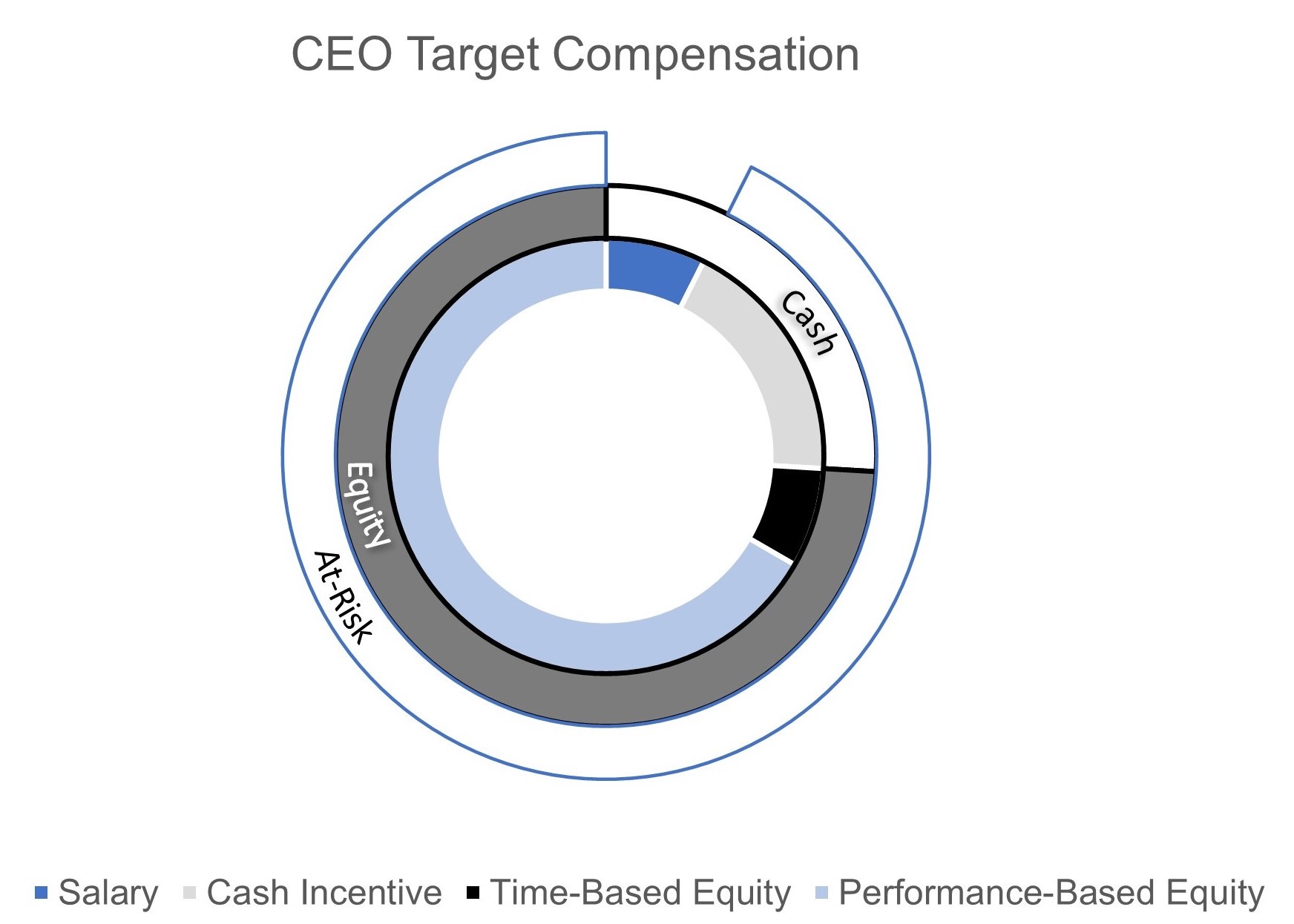
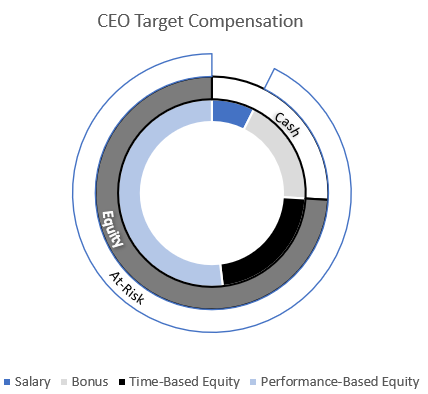

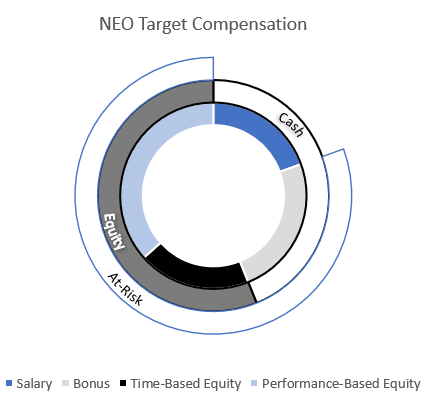
| Element | Why We Use This Element | ||||||||||||||||
| Fixed | Annual | Salary | |||||||||||||||
| Variable | Measures the annual growth in policies in force and profitability in our insurance businesses | ||||||||||||||||
| Progressive Capital Management | Measures the performance of our fixed-income portfolio over a one-year and a three-year period against the performance results of a benchmark group | ||||||||||||||||
| Long-Term | Performance-Based Restricted Stock Growth in Market Share* | Rewards our profitable growth in market share of our insurance businesses over a three-year period | |||||||||||||||
Performance-Based Restricted Stock Investment Results* | Measures the performance of our fixed-income portfolio over a three-year period against the performance results of a benchmark group | ||||||||||||||||
| Time-Based Restricted Stock Units | Further | ||||||||||||||||
| Name | Name | 2020 Salary1 | Change From Prior Salary | Name | 2023 Salary1 | Change From Prior Salary | ||||||||||
| Susan Patricia Griffith | $950,000 | 5.6 | % | |||||||||||||
Susan Patricia Griffith2 | Susan Patricia Griffith2 | $1,000,000 | 5.3 | % | ||||||||||||
| John P. Sauerland | John P. Sauerland | 650,000 | 4.0 | |||||||||||||
| Patrick K. Callahan | Patrick K. Callahan | 550,000 | 10.0 | |||||||||||||
| John A. Barbagallo | 505,000 | — | ||||||||||||||
| Michael D. Sieger | 500,000 | 5.3 | ||||||||||||||
| Karen B. Bailo | ||||||||||||||||
| John Murphy | ||||||||||||||||
| Business Unit | Combined Ratio1 | Increase in Policies in Force (%)2 | |||||||||
| Agency | 85.8 | 9 | % | ||||||||
| Direct | 87.7 | 13 | |||||||||
| Special lines | — | 6 | |||||||||
| Commercial Lines | 87.0 | 7 | |||||||||
| Property | 107.1 | 8 | |||||||||
| Business Unit | Business Unit Performance Score | Weighting Factor (%) | Weighted Performance Score | ||||||||
| Agency auto | 2.00 | 37.8 | % | .76 | |||||||
| Direct auto | 2.00 | 41.2 | .82 | ||||||||
| Special lines | 2.00 | 4.9 | .10 | ||||||||
| Commercial Lines | 2.00 | 11.9 | .24 | ||||||||
| Property | 0.00 | 4.2 | .00 | ||||||||
| Gainshare Factor | 1.92 | ||||||||||
Performance-Based Award Target Value (Multiple of Salary)1, 2 | Time-Based Award Value (Multiple of Salary)2 | ||||||||||
| Name | 2023 | 2023 | |||||||||
| Susan Patricia Griffith | 9.00 | x | 3 | 1.00 | x | ||||||
| John P. Sauerland | 2.75 | 3 | 1.00 | ||||||||
| Patrick K. Callahan | 2.75 | 1.00 | |||||||||
| Karen B. Bailo | 1.50 | 1.00 | |||||||||
| John Murphy | 1.50 | 1.00 | |||||||||
Performance vs. Business Line Market1 | Determination of the Performance Score for the Business Line | |||||||
| If our growth for the business line exceeds the market growth rate by the maximum measure for that business line or more | Score will be 2.5x; this is the maximum possible score | |||||||
| If our growth rate for the business line exceeds the market growth rate by more than the target measure for that business line but less than the maximum measure for that business line | Score will be between 1.0x and 2.5x, in proportion to the extent to which each business | |||||||
| If our growth rate for the business line exceeds the market growth rate by less than the target measure for that business line | Score will be up to 1.0x of the target in proportion to the extent to which each business | |||||||
| If the business | The score for the business line will be 0 | |||||||
| Business Line | Target Growth Rate Measure | Maximum Growth Rate Measure | ||||||
| Private passenger auto | Two percentage points | Three and a half percentage points | ||||||
| Commercial auto | Two percentage points | Three and a half percentage points | ||||||
| Score=0 Rank at or below the percentile | Score=1.0 Rank equal to the percentile | Score=2.0 Rank at or above the percentile | ||||||
25th | 50th | 75th | ||||||
| Paid Salary | X | Target Percentage | X | Gainshare (i.e., Performance) Factor | = | Annual Incentive Payment | ||||||||||||||
| Name | 2023 Target (Multiple of Salary) | ||||
| Susan Patricia Griffith | 2.50 | x | |||
| John P. Sauerland | 1.50 | ||||
| Patrick K. Callahan | 1.50 | ||||
| Karen B. Bailo | 1.00 | ||||
| John Murphy | 1.00 | ||||
| Time-Based Award Value (Multiple of Salary) | Performance-Based Award Target Value (Multiple of Salary)1 | |||||||||||||||||||
| Name | 2020 | 2019 | 2020 | 2019 | ||||||||||||||||
| Susan Patricia Griffith | 3.00 | x | 3.00 | x | 7.00 | x | 2 | 7.00 | x | |||||||||||
| John P. Sauerland | 1.00 | 1.00 | 2.50 | 2 | 2.50 | |||||||||||||||
| Patrick K. Callahan | 1.00 | 1.00 | 2.00 | 1.75 | ||||||||||||||||
| John A. Barbagallo | 1.00 | 1.00 | 1.50 | 1.25 | ||||||||||||||||
| Michael D. Sieger | 1.00 | 1.00 | 1.50 | 1.50 | ||||||||||||||||
| Business Unit | Combined Ratio | Increase in Policies in Force (%)3 | |||||||||
| Agency auto | 95.1 | 8 | % | ||||||||
| Direct auto | 92.7 | 14 | |||||||||
Special lines1 | — | 6 | |||||||||
Commercial Lines2 | 98.8 | 5 | |||||||||
Property2 | 98.9 | 4 | |||||||||
| Matrix | Performance Score | Weighting Factor (%) | Weighted Performance Score | ||||||||
| Agency auto | 1.92 | 33.7 | % | 0.64 | |||||||
| Direct auto | 2.00 | 40.9 | 0.82 | ||||||||
| Special lines | 2.00 | 4.5 | 0.09 | ||||||||
| Commercial Lines | 1.31 | 16.9 | 0.22 | ||||||||
Property – growth1 | 0.00 | 1.8 | 0.00 | ||||||||
Property – limited2 | 0.30 | 2.2 | 0.01 | ||||||||
| Gainshare Factor | 1.78 | ||||||||||
COMPENSATION COMMITTEE REPORT The following Compensation Committee Report does not constitute soliciting material and should not be deemed filed or incorporated by reference into any other Progressive filing under the Securities Act of 1933 or the Securities Exchange Act of 1934, except to the extent Progressive specifically incorporates this Report by reference therein. The Compensation and Talent Committee of the Board of Directors of The Progressive Corporation COMPENSATION AND TALENT COMMITTEE Roger N. Farah, Chair Pamela J. Craig Barbara R. Snyder | ||
| Name and Principal Position | ||||||||||||||||||||||||||||||||||||||||||||
| Name and Principal Position | ||||||||||||||||||||||||||||||||||||||||||||
| Name and Principal Position | Name and Principal Position | Year | Salary1 ($) | Stock Awards2 ($) | Non-Equity Incentive Plan Compensation3 ($) | All Other Compensation4 ($) | Total ($) | Year | Salary1 ($) | Stock Awards2 ($) | Non-Equity Incentive Plan Compensation3 ($) | All Other Compensation4 ($) | Total ($) | |||||||||||||||||||||||||||||||
| Susan Patricia Griffith | Susan Patricia Griffith | 2020 | $980,770 | $9,500,037 | $4,707,694 | $32,022 | $15,220,523 | |||||||||||||||||||||||||||||||||||||
| President and Chief Executive Officer | President and Chief Executive Officer | 2019 | 888,461 | 9,000,104 | 4,047,253 | 105,454 | 14,041,272 | |||||||||||||||||||||||||||||||||||||
| 2018 | 791,346 | 11,000,133 | 2,267,207 | 114,239 | 14,172,925 | |||||||||||||||||||||||||||||||||||||||
| John P. Sauerland | John P. Sauerland | 2020 | 672,115 | 2,275,137 | 1,935,692 | 12,750 | 4,895,694 | |||||||||||||||||||||||||||||||||||||
| Vice President and Chief Financial Officer | Vice President and Chief Financial Officer | 2019 | 622,115 | 2,187,622 | 1,746,713 | 12,000 | 4,568,450 | |||||||||||||||||||||||||||||||||||||
| 2018 | 597,115 | 5,100,092 | 1,425,613 | 12,000 | 7,134,820 | |||||||||||||||||||||||||||||||||||||||
| Patrick K. Callahan | Patrick K. Callahan | 2020 | 565,384 | 1,650,123 | 1,628,307 | 12,000 | 3,855,814 | |||||||||||||||||||||||||||||||||||||
| Personal Lines President | Personal Lines President | 2019 | 491,346 | 1,375,087 | 1,351,399 | 12,000 | 3,229,832 | |||||||||||||||||||||||||||||||||||||
| 2018 | 418,654 | 935,031 | 799,629 | 12,000 | 2,165,314 | |||||||||||||||||||||||||||||||||||||||
John A. Barbagallo5 | 2020 | 524,423 | 1,262,565 | 1,006,892 | 12,750 | 2,806,630 | ||||||||||||||||||||||||||||||||||||||
| Karen B. Bailo | ||||||||||||||||||||||||||||||||||||||||||||
| Commercial Lines President | Commercial Lines President | 2019 | 503,269 | 1,136,325 | 961,244 | 12,000 | 2,612,838 | |||||||||||||||||||||||||||||||||||||
| 2018 | 488,269 | 1,078,081 | 932,595 | 12,000 | 2,510,945 | |||||||||||||||||||||||||||||||||||||||
| Michael D. Sieger | 2020 | 516,346 | 1,250,095 | 991,384 | 12,750 | 2,770,575 | ||||||||||||||||||||||||||||||||||||||
| John Murphy | ||||||||||||||||||||||||||||||||||||||||||||
| Claims President | Claims President | 2019 | 469,231 | 1,187,618 | 896,231 | 12,000 | 2,565,080 | |||||||||||||||||||||||||||||||||||||
| 2018 | 418,654 | 935,031 | 799,629 | 12,000 | 2,165,314 | |||||||||||||||||||||||||||||||||||||||
| Name | Name | Grant Year | Grant Date Fair Value (Maximum Performance) | Name | Grant Year | Grant Date Fair Value (Maximum Performance) | |||||||||||||||
| Susan Patricia Griffith | Susan Patricia Griffith | 2020 | $16,150,070 | ||||||||||||||||||
| 2019 | 15,300,126 | ||||||||||||||||||||
| 2018 | 13,600,189 | ||||||||||||||||||||
| 2022 | 2022 | 16,150,367 | |||||||||||||||||||
| 2021 | 2021 | 16,150,288 | |||||||||||||||||||
| John P. Sauerland | John P. Sauerland | 2020 | 3,997,763 | John P. Sauerland | 2023 | 4,655,368 | |||||||||||||||
| 2019 | 3,843,875 | ||||||||||||||||||||
| 2018 | 3,690,058 | ||||||||||||||||||||
| 2022 | 2022 | 4,489,006 | |||||||||||||||||||
| 2021 | 2021 | 4,322,660 | |||||||||||||||||||
| Patrick K. Callahan | Patrick K. Callahan | 2020 | 2,750,148 | Patrick K. Callahan | 2023 | 4,469,014 | |||||||||||||||
| 2019 | 2,187,622 | ||||||||||||||||||||
| 2018 | 1,275,014 | ||||||||||||||||||||
| John A. Barbagallo | 2020 | 1,893,880 | |||||||||||||||||||
| 2019 | 1,578,148 | ||||||||||||||||||||
| 2018 | 1,470,069 | ||||||||||||||||||||
| Michael D. Sieger | 2020 | 1,875,109 | |||||||||||||||||||
| 2019 | 1,781,427 | ||||||||||||||||||||
| 2018 | 1,275,014 | ||||||||||||||||||||
| 2022 | 2022 | 4,297,017 | |||||||||||||||||||
| 2021 | 2021 | 3,750,203 | |||||||||||||||||||
| Karen B. Bailo | Karen B. Bailo | 2023 | 2,250,153 | ||||||||||||||||||
| 2022 | 2022 | 2,062,535 | |||||||||||||||||||
| 2021 | 2021 | 1,250,263 | |||||||||||||||||||
| John Murphy | John Murphy | 2023 | 2,175,055 | ||||||||||||||||||
| 2022 | 2022 | 2,062,535 | |||||||||||||||||||
| 2021 | 2021 | 1,562,603 | |||||||||||||||||||
| Name | Name | 401(k) Employer Contributionsa | Perquisitesb | Otherc | ||||||||||||||||||
| Name | ||||||||||||||||||||||
| Name | ||||||||||||||||||||||
| Susan Patricia Griffith | ||||||||||||||||||||||
| Susan Patricia Griffith | ||||||||||||||||||||||
| Susan Patricia Griffith | Susan Patricia Griffith | $12,000 | $20,022 | $— | ||||||||||||||||||
| John P. Sauerland | John P. Sauerland | 12,000 | — | 750 | ||||||||||||||||||
| John P. Sauerland | ||||||||||||||||||||||
| John P. Sauerland | ||||||||||||||||||||||
| Patrick K. Callahan | Patrick K. Callahan | 12,000 | — | — | ||||||||||||||||||
| John A. Barbagallo | 12,000 | — | 750 | |||||||||||||||||||
| Michael D. Sieger | 12,000 | — | 750 | |||||||||||||||||||
| Patrick K. Callahan | ||||||||||||||||||||||
| Patrick K. Callahan | ||||||||||||||||||||||
| Karen B. Bailo | ||||||||||||||||||||||
| Karen B. Bailo | ||||||||||||||||||||||
| Karen B. Bailo | ||||||||||||||||||||||
| John Murphy | ||||||||||||||||||||||
| John Murphy | ||||||||||||||||||||||
| John Murphy | ||||||||||||||||||||||
Estimated Future Payouts Under Non-Equity Incentive Plan Awards1 | Estimated Future Payouts Under Equity Incentive Plan Awards | Grant Date Fair Value of Equity Awards2 ($) | ||||||||||||||||||||||||||||||||||||
| Name | Grant Date | Threshold ($) | Target ($) | Maximum ($) | Threshold (#) | Target (#) | Maximum (#) | |||||||||||||||||||||||||||||||
| Susan Patricia Griffith | NA | 0 | $2,485,577 | $4,971,154 | ||||||||||||||||||||||||||||||||||
| 3/20/2023 | 7,191 | 3 | $1,000,052 | |||||||||||||||||||||||||||||||||||
| 3/20/2023 | 0 | 4 | 64,716 | 4 | 158,195 | 4 | 9,000,054 | |||||||||||||||||||||||||||||||
| John P. Sauerland | NA | 0 | 1,045,673 | 2,091,346 | ||||||||||||||||||||||||||||||||||
| 3/20/2023 | 5,034 | 3 | 700,078 | |||||||||||||||||||||||||||||||||||
| 3/20/2023 | 0 | 4 | 13,843 | 4 | 33,475 | 4 | 1,925,146 | |||||||||||||||||||||||||||||||
| Patrick K. Callahan | NA | 0 | 970,673 | 1,941,346 | ||||||||||||||||||||||||||||||||||
| 3/20/2023 | 4,674 | 3 | 650,013 | |||||||||||||||||||||||||||||||||||
| 3/20/2023 | 0 | 4 | 12,854 | 4 | 32,135 | 4 | 1,787,606 | |||||||||||||||||||||||||||||||
| Karen B. Bailo | NA | 0 | 594,231 | 1,188,462 | ||||||||||||||||||||||||||||||||||
| 3/20/2023 | 4,315 | 3 | 600,087 | |||||||||||||||||||||||||||||||||||
| 3/20/2023 | 0 | 4 | 6,472 | 4 | 16,180 | 4 | 900,061 | |||||||||||||||||||||||||||||||
| John Murphy | NA | 0 | 576,539 | 1,153,078 | ||||||||||||||||||||||||||||||||||
| 3/20/2023 | 4,171 | 3 | 580,061 | |||||||||||||||||||||||||||||||||||
| 3/20/2023 | 0 | 4 | 6,256 | 4 | 15,640 | 4 | 870,022 | |||||||||||||||||||||||||||||||
Estimated Future Payouts Under Non-Equity Incentive Plan Awards1 | Estimated Future Payouts Under Equity Incentive Plan Awards | Grant Date Fair Value of Equity Awards2 | |||||||||||||||||||||||||||||||||
| Name | Grant Date | Threshold ($) | Target ($) | Maximum ($) | Threshold (#) | Target (#) | Maximum (#) | ||||||||||||||||||||||||||||
| Susan Patricia Griffith | NA | 0 | $2,451,924 | $4,903,848 | |||||||||||||||||||||||||||||||
| 3/19/2020 | 42,512 | 3 | $2,850,004 | ||||||||||||||||||||||||||||||||
| 3/19/2020 | 0 | 4 | 99,195 | 4 | 240,902 | 4 | 6,650,033 | ||||||||||||||||||||||||||||
| John P. Sauerland | NA | 0 | 1,008,173 | 2,016,346 | |||||||||||||||||||||||||||||||
| 3/19/2020 | 9,696 | 3 | 650,020 | ||||||||||||||||||||||||||||||||
| 3/19/2020 | 0 | 4 | 24,241 | 4 | 59,633 | 4 | 1,625,117 | ||||||||||||||||||||||||||||
| Patrick K. Callahan | NA | 0 | 848,077 | 1,696,154 | |||||||||||||||||||||||||||||||
| 3/19/2020 | 8,205 | 3 | 550,063 | ||||||||||||||||||||||||||||||||
| 3/19/2020 | 0 | 4 | 16,409 | 4 | 41,023 | 4 | 1,100,059 | ||||||||||||||||||||||||||||
| John A. Barbagallo | NA | 0 | 524,423 | 1,048,846 | |||||||||||||||||||||||||||||||
| 3/19/2020 | 7,533 | 3 | 505,012 | ||||||||||||||||||||||||||||||||
| 3/19/2020 | 0 | 4 | 11,300 | 4 | 28,250 | 4 | 757,552 | ||||||||||||||||||||||||||||
| Michael D. Sieger | NA | 0 | 516,346 | 1,032,692 | |||||||||||||||||||||||||||||||
| 3/19/2020 | 7,459 | 3 | 500,051 | ||||||||||||||||||||||||||||||||
| 3/19/2020 | 0 | 4 | 11,188 | 4 | 27,970 | 4 | 750,044 | ||||||||||||||||||||||||||||
Stock or Unit Awards1 | |||||||||||||||||||||||||||||||||||||||||||||||||||||||||
Stock or Unit Awards1 | Stock or Unit Awards1 | ||||||||||||||||||||||||||||||||||||||||||||||||||||||||
| Name | Name | Equity Incentive Plan Awards: Number of Unearned Units That Have Not Vested (#) | Equity Incentive Plan Awards: Market Value of Unearned Units That Have Not Vested ($) | Name | Number of Shares or Units of Stock That Have Not Vested (#)2 | Market Value of Shares or Units of Stock That Have Not Vested ($) | Equity Incentive Plan Awards: Number of Unearned Units That Have Not Vested (#) | Equity Incentive Plan Awards: Market Value of Unearned Units That Have Not Vested ($) | |||||||||||||||||||||||||||||||||||||||||||||||||
| Susan Patricia Griffith | Susan Patricia Griffith | 159,685 | 2 | $15,789,618 | |||||||||||||||||||||||||||||||||||||||||||||||||||||
| 670,742 | 3 | 66,322,941 | |||||||||||||||||||||||||||||||||||||||||||||||||||||||
| 482,737 | |||||||||||||||||||||||||||||||||||||||||||||||||||||||||
| John P. Sauerland | John P. Sauerland | 75,728 | 2 | 7,487,950 | |||||||||||||||||||||||||||||||||||||||||||||||||||||
| 175,466 | 3 | 17,350,031 | |||||||||||||||||||||||||||||||||||||||||||||||||||||||
| 121,504 | |||||||||||||||||||||||||||||||||||||||||||||||||||||||||
| Patrick K. Callahan | Patrick K. Callahan | 33,205 | 2 | 3,283,334 | |||||||||||||||||||||||||||||||||||||||||||||||||||||
| 94,662 | 3 | 9,360,194 | |||||||||||||||||||||||||||||||||||||||||||||||||||||||
| John A. Barbagallo | 22,298 | 2 | 2,204,838 | ||||||||||||||||||||||||||||||||||||||||||||||||||||||
| 76,565 | 3 | 7,570,776 | |||||||||||||||||||||||||||||||||||||||||||||||||||||||
| Michael D. Sieger | 19,929 | 2 | 1,970,531 | ||||||||||||||||||||||||||||||||||||||||||||||||||||||
| 75,772 | 3 | 7,492,288 | |||||||||||||||||||||||||||||||||||||||||||||||||||||||
| 114,180 | |||||||||||||||||||||||||||||||||||||||||||||||||||||||||
| Karen B. Bailo | |||||||||||||||||||||||||||||||||||||||||||||||||||||||||
| 49,329 | |||||||||||||||||||||||||||||||||||||||||||||||||||||||||
| John Murphy | |||||||||||||||||||||||||||||||||||||||||||||||||||||||||
| 52,329 | |||||||||||||||||||||||||||||||||||||||||||||||||||||||||
| Name | 1/1/21 | 1/1/22 | 1/1/23 | 1/1/24 | 1/1/25 | |||||||||||||||
| Susan Patricia Griffith | 41,816 | 39,354 | 43,657 | 20,638 | 14,220 | |||||||||||||||
| John P. Sauerland | 23,374 | 21,880 | 22,501 | 4,729 | 3,244 | |||||||||||||||
| Patrick K. Callahan | 9,509 | 8,230 | 7,599 | 5,122 | 2,745 | |||||||||||||||
| John A. Barbagallo | 6,114 | 4,795 | 5,149 | 3,720 | 2,520 | |||||||||||||||
| Michael D. Sieger | 4,891 | 4,056 | 4,863 | 3,624 | 2,495 | |||||||||||||||
| Name | 1/1/24 | 1/16/24 | 1/1/25 | 1/21/25 | 1/20/26 | 1/19/27 | 1/18/28 | |||||||||||||||||||
| Susan Patricia Griffith | 22,174 | 10,771 | 15,279 | 19,494 | 21,896 | 11,126 | 2,402 | |||||||||||||||||||
| John P. Sauerland | 5,081 | 2,456 | 3,485 | 4,523 | 6,205 | 3,748 | 1,682 | |||||||||||||||||||
| Patrick K. Callahan | 5,503 | 2,267 | 2,949 | 4,180 | 5,742 | 3,475 | 1,562 | |||||||||||||||||||
| Karen B. Bailo | 2,522 | 1,512 | 2,083 | 3,195 | 4,637 | 3,125 | 1,441 | |||||||||||||||||||
| John Murphy | 4,456 | 1,890 | 2,413 | 3,573 | 4,967 | 3,077 | 1,393 | |||||||||||||||||||
| Name | Name | 2018 | 2019 | 2020 | ||||||||||||
| Name | ||||||||||||||||
| Name | ||||||||||||||||
| Susan Patricia Griffith | ||||||||||||||||
| Susan Patricia Griffith | ||||||||||||||||
| Susan Patricia Griffith | Susan Patricia Griffith | 237,870 | 205,345 | 227,527 | ||||||||||||
| John P. Sauerland | John P. Sauerland | 64,540 | 53,031 | 57,895 | ||||||||||||
| John P. Sauerland | ||||||||||||||||
| John P. Sauerland | ||||||||||||||||
| Patrick K. Callahan | Patrick K. Callahan | 22,300 | 31,195 | 41,167 | ||||||||||||
| John A. Barbagallo | 25,712 | 22,504 | 28,349 | |||||||||||||
| Michael D. Sieger | 22,300 | 25,403 | 28,069 | |||||||||||||
| Patrick K. Callahan | ||||||||||||||||
| Patrick K. Callahan | ||||||||||||||||
| Karen B. Bailo | ||||||||||||||||
| Karen B. Bailo | ||||||||||||||||
| Karen B. Bailo | ||||||||||||||||
| John Murphy | ||||||||||||||||
| John Murphy | ||||||||||||||||
| John Murphy | ||||||||||||||||
| Type | Measurement Period | Vesting Range | CR | Growth Rate Over Base | Reported Value | Expiration Date | ||||||||||||||
Performance versus Marketa | ||||||||||||||||||||
| 2018 | 1/1/18-12/31/20 | 0-250% | 96 | varies | Max | 1/31/2023 | ||||||||||||||
| 2019 | 1/1/19-12/31/21 | 0-250% | 96 | varies | Max | 1/31/2024 | ||||||||||||||
| 2020 | 1/1/20-12/31/22 | 0-250% | 96 | varies | Max | 1/31/2025 | ||||||||||||||
Investmentb | ||||||||||||||||||||
2018c | 1/1/18-12/31/20 | 0-200% | NA | NA | Max | 3/15/2021 | ||||||||||||||
| 2019 | 1/1/19-12/31/21 | 0-200% | NA | NA | Target | 3/15/2022 | ||||||||||||||
| 2020 | 1/1/20-12/31/22 | 0-200% | NA | NA | Target | 3/15/2023 | ||||||||||||||
| Type | Measurement Period | Vesting Range | Combined Ratio | Growth Rate Over Base | Reported Value | Expiration Date | ||||||||||||||
Performance versus Marketa | ||||||||||||||||||||
| 2021 | 1/1/21-12/31/23 | 0-250% | 96 | Varies | Max | 1/31/2026 | ||||||||||||||
| 2022 | 1/1/22-12/31/24 | 0-250% | 96 | Varies | Max | 1/31/2027 | ||||||||||||||
| 2023 | 1/1/23-12/31/25 | 0-250% | 96 | 0-3.5% | Max | 1/31/2028 | ||||||||||||||
Investmentb | ||||||||||||||||||||
2021c | 1/1/21-12/31/23 | 0-200% | NA | NA | Max | 3/15/2024 | ||||||||||||||
| 2022 | 1/1/22-12/31/24 | 0-200% | NA | NA | Max | 3/15/2025 | ||||||||||||||
| 2023 | 1/1/23-12/31/25 | 0-200% | NA | NA | Target | 3/15/2026 | ||||||||||||||
| Stock Awards | ||||||||
Number of Shares Acquired on Vesting1 | Value Realized on Vesting2 | |||||||
| Name | (#) | ($) | ||||||
| Susan Patricia Griffith | 308,894 | $26,681,393 | ||||||
| John P. Sauerland | 93,770 | 8,091,327 | ||||||
| Patrick K. Callahan | 37,914 | 3,190,817 | ||||||
| John A. Barbagallo | 46,511 | 3,982,581 | ||||||
| Michael D. Sieger | 35,638 | 3,058,569 | ||||||
| Stock Awards | ||||||||
Number of Shares Acquired on Vesting1 | Value Realized on Vesting | |||||||
| Name | (#) | ($) | ||||||
| Susan Patricia Griffith | 299,425 | $ | 46,828,744 | |||||
| John P. Sauerland | 86,857 | 13,315,273 | ||||||
| Patrick K. Callahan | 51,489 | 8,152,273 | ||||||
| Karen B. Bailo | 6,520 | 963,863 | ||||||
| John Murphy | 28,795 | 4,488,127 | ||||||
| Vesting Date | 1/1/2020 | 2/18/2020 | 7/20/2020 | |||||||||||||||||||||||||||||||||||||||||
| Value at Vesting | $ | 73.81 | $ | 83.60 | $ | 87.92 | ||||||||||||||||||||||||||||||||||||||
| Type | TB | PB | ||||||||||||||||||||||||||||||||||||||||||
| Vesting Date | Vesting Date | 1/3/2023 | 2/21/2023 | 11/27/2023 | ||||||||||||||||||||||||||||||||||||||||
| Value at Vesting | ||||||||||||||||||||||||||||||||||||||||||||
| Type | Type | TB | PB | |||||||||||||||||||||||||||||||||||||||||
| Name | Name | Performance Factor | NA | 2.00 | 2.50 | |||||||||||||||||||||||||||||||||||||||
| Susan Patricia Griffith | Susan Patricia Griffith | 21,669 | 39,533 | 247,692 | ||||||||||||||||||||||||||||||||||||||||
| John P. Sauerland | John P. Sauerland | 8,920 | 6,272 | 78,578 | ||||||||||||||||||||||||||||||||||||||||
| Patrick K. Callahan | Patrick K. Callahan | 10,103 | — | 27,811 | ||||||||||||||||||||||||||||||||||||||||
| John A. Barbagallo | 7,561 | — | 38,950 | |||||||||||||||||||||||||||||||||||||||||
| Michael D. Sieger | 5,298 | — | 30,340 | |||||||||||||||||||||||||||||||||||||||||
| Karen B. Bailo | ||||||||||||||||||||||||||||||||||||||||||||
| John Murphy | ||||||||||||||||||||||||||||||||||||||||||||
Executive Contributions in Last Fiscal Year1 | Registrant Contributions in Last Fiscal Year2 | Aggregate Earnings (Losses) in Last Fiscal Year | Aggregate Withdrawals/ Distributions3 | Aggregate Balance at Last Fiscal Year End4 | |||||||||||||||||||||||||||||||||||
| Executive Contributions in Last Fiscal Year | Executive Contributions in Last Fiscal Year | Registrant Contributions in Last Fiscal Year1 | Aggregate Earnings (Losses) in Last Fiscal Year | Aggregate Withdrawals/ Distributions2 | Aggregate Balance at Last Fiscal Year End3 | ||||||||||||||||||||||||||||||||||
| Name | Name | ($) | Name | ($) | |||||||||||||||||||||||||||||||||||
| Susan Patricia Griffith | Susan Patricia Griffith | $— | $154,540 | $— | $1,080,749 | ||||||||||||||||||||||||||||||||||
| John P. Sauerland | John P. Sauerland | — | — | 72,961 | 127,182 | 577,173 | |||||||||||||||||||||||||||||||||
| Patrick K. Callahan | Patrick K. Callahan | 2,224,376 | — | 2,112,959 | — | 9,663,002 | |||||||||||||||||||||||||||||||||
| John A. Barbagallo | 865,120 | — | 275,945 | — | 5,133,305 | ||||||||||||||||||||||||||||||||||
| Michael D. Sieger | — | — | 417,597 | 367,339 | 1,788,529 | ||||||||||||||||||||||||||||||||||
| Karen B. Bailo | |||||||||||||||||||||||||||||||||||||||
| John Murphy | |||||||||||||||||||||||||||||||||||||||
Potential Payments The Executive is Eligible to Receive1: | |||||||||||||||||
| Under Equity Plan | |||||||||||||||||
| If This Triggering Event Occurs: | Severance Benefits | Change in Control Benefits2 | Qualified Retirement Benefits | Other Termination Provisions | Payments under EDCP3 | ||||||||||||
| Involuntary termination (without cause) | ü | ü | |||||||||||||||
| Voluntary separation (including nonqualified retirement) | ü | ü | |||||||||||||||
Retirement – qualified (as defined in the plan)4 | ü | ü | |||||||||||||||
| Termination for cause | ü | ||||||||||||||||
| Change in control, no loss of employment | ü | ||||||||||||||||
| Change in control and involuntary termination (without cause) or resignation due to a significant job change | ü | ü | ü | ||||||||||||||
| Death | ü | ü | ü | ||||||||||||||
Is the Executive Eligible to Receive1: | |||||||||||||||||
| Under Equity Plan | |||||||||||||||||
| If This Triggering Event Occurs: | Severance Benefits? | Change in Control Benefits2? | Qualified Retirement Benefits? | Other Termination Provisions? | Payments under EDCP3? | ||||||||||||
| Involuntary termination (without cause) | ü | – | – | – | ü | ||||||||||||
| Voluntary separation (including nonqualified retirement) | – | – | – | ü | ü | ||||||||||||
Retirement – qualified (as defined in the plan)4 | – | – | ü | – | ü | ||||||||||||
| Termination for cause | – | – | – | – | ü | ||||||||||||
| Change in control, no loss of employment | – | ü | – | – | ü | ||||||||||||
| Change in control and involuntary termination (without cause) or resignation due to a significant job change | ü | ü | – | – | ü | ||||||||||||
| Death | – | – | ü | ü | ü | ||||||||||||
| Name | Amount of Severance Payment ($) | Estimated Value of Health Benefits ($) | |||||||||
| Susan Patricia Griffith | $3,000,000 | $26,779 | |||||||||
| John P. Sauerland | 2,100,000 | 26,779 | |||||||||
| Patrick K. Callahan | 1,950,000 | 26,779 | |||||||||
| Karen B. Bailo | 1,800,000 | 23,044 | |||||||||
| John Murphy | 1,740,000 | 26,779 | |||||||||
| Name | Amount of Severance Payment ($) | Estimated Value of Health Benefits ($) | |||||||||
| Susan Patricia Griffith | $2,850,000 | $23,210 | |||||||||
| John P. Sauerland | 1,950,000 | 32,339 | |||||||||
| Patrick K. Callahan | 1,650,000 | 23,001 | |||||||||
| John A. Barbagallo | 1,515,000 | 23,001 | |||||||||
| Michael D. Sieger | 1,500,000 | 23,001 | |||||||||
| Name | Payments on Unvested Restricted Stock Unit Awards/Total1 ($) | ||||||||||
| Susan Patricia Griffith | $ | ||||||||||
| John P. Sauerland | |||||||||||
| Patrick K. Callahan | |||||||||||
Value of Qualified Retirement Benefits1,2 (As of 12/31/2020) | |||||||||||
| Time-Based Equity Awards | Performance-Based Equity Awards3 | ||||||||||
Name4 | Maximum5 | ||||||||||
| Susan Patricia Griffith | $2,109,169 | $68,998,167 | |||||||||
| John P. Sauerland | 481,052 | 17,718,824 | |||||||||
| John A. Barbagallo | 373,738 | 7,570,776 | |||||||||
| Michael D. Sieger | 370,067 | 7,492,288 | |||||||||
Value of Qualified Retirement Benefits1 (As of 12/31/2023) | |||||||||||
| Time-Based Equity Awards | Performance-Based Equity Awards at Maximum | ||||||||||
| Name | |||||||||||
| Susan Patricia Griffith | $11,748,573 | $52,784,066 | |||||||||
| John P. Sauerland | 2,716,268 | 14,371,024 | |||||||||
| Karen B. Bailo | 1,526,836 | 5,274,114 | |||||||||
| Year | Summary Compensation Table Total for CEO | Compensation Actually Paid to CEO1 | Average Summary Compensation Table Total for Non-CEO Named Executive Officers | Average Compensation Actually Paid to Non-CEO Named Executive Officers2 | Value of initial fixed $100 investment based on3: | Net Income (in billions) | Combined Ratio5 | |||||||||||||||||||
| Total Shareholder Return | Peer Group Total Shareholder Return4 | |||||||||||||||||||||||||
| 2023 | $ | 15,636,618 | $ | 49,003,116 | $ | 4,062,285 | $ | 9,728,818 | $ | 244.66 | $ | 164.49 | $ | 3.9 | 94.9 | |||||||||||
| 2022 | 12,748,826 | 48,474,661 | 3,171,093 | 9,195,384 | 198.67 | 148.53 | 0.7 | 95.8 | ||||||||||||||||||
| 2021 | 14,462,961 | 26,403,691 | 3,668,598 | 5,359,600 | 156.68 | 124.95 | 3.4 | 95.3 | ||||||||||||||||||
| 2020 | 15,220,523 | 52,840,789 | 3,582,178 | 10,086,445 | 141.38 | 106.33 | 5.7 | 87.7 | ||||||||||||||||||
| 2023 | 2022 | 2021 | 2020 | |||||||||||
| Closing stock price as of last trading day of year | $159.28 | $129.71 | $102.65 | $98.88 | ||||||||||
Deduction of the grant date fair value of awards reported in the "Stock Awards" column of the Summary Compensation Table (Stock Awards) for the covered fiscal year | $ | (10,000,106) | $ | (9,500,203) | $ | (9,500,212) | $ | (9,500,037) | ||||||
Addition of the year-end fair value of all Stock Awards granted during the covered fiscal year that are outstanding and unvested | 20,662,548 | 16,357,106 | 12,631,713 | 25,872,505 | ||||||||||
Change in the year-end fair value (from prior year-end) of all Stock Awards granted in any prior fiscal year that are outstanding and unvested | 15,038,380 | 23,872,689 | 8,498,852 | 16,252,534 | ||||||||||
Change in the fair value (from prior year-end to vesting date) of all Stock Awards granted in any prior fiscal year that vested | 7,665,676 | 4,996,243 | 310,377 | 4,995,264 | ||||||||||
| Total Adjustments | $ | 33,366,498 | $ | 35,725,835 | $ | 11,940,730 | $ | 37,620,266 | ||||||
| 2023 | 2022 | 2021 | 2020 | |||||||||||
Deduction of the grant date fair value of Stock Awards for the covered fiscal year | $ | (2,003,269) | $ | (1,906,333) | $ | (2,134,497) | $ | (1,609,480) | ||||||
Addition of the year-end fair value of all Stock Awards granted during the covered fiscal year that are outstanding and unvested | 3,782,595 | 3,359,339 | 2,755,577 | 4,507,590 | ||||||||||
Change in the year-end fair value (from prior year-end) of all Stock Awards granted in any prior fiscal year that are outstanding and unvested | 2,854,453 | 3,915,370 | 1,061,423 | 2,787,532 | ||||||||||
Change in the fair value (from prior year-end to vesting date) of all Stock Awards granted in any prior fiscal year that vested | 1,032,754 | 655,915 | 8,499 | 818,625 | ||||||||||
| Total Adjustments | $ | 5,666,533 | $ | 6,024,291 | $ | 1,691,002 | $ | 6,504,267 | ||||||
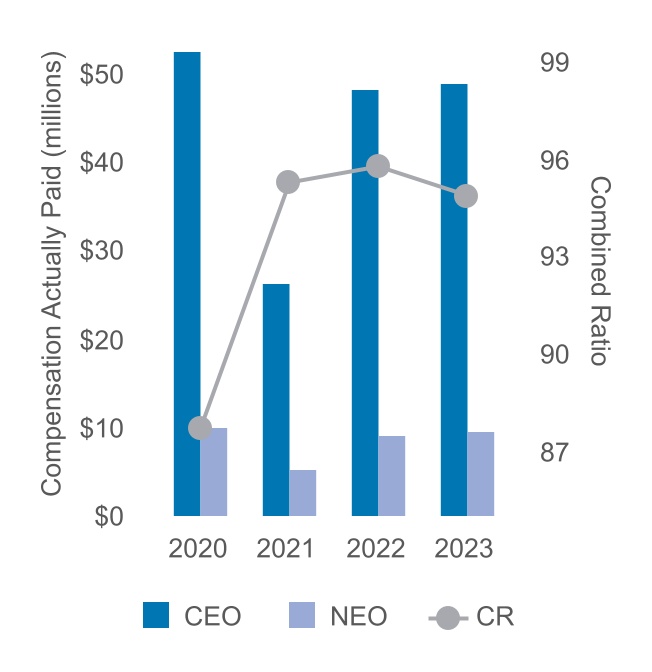
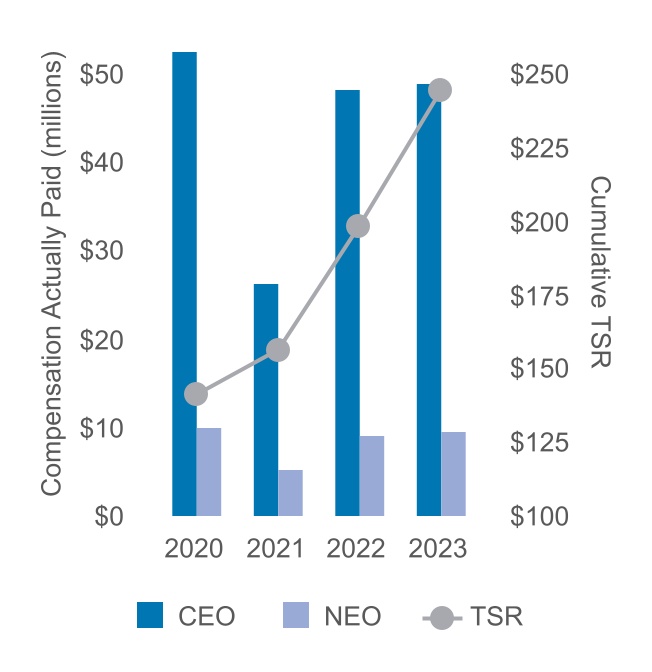
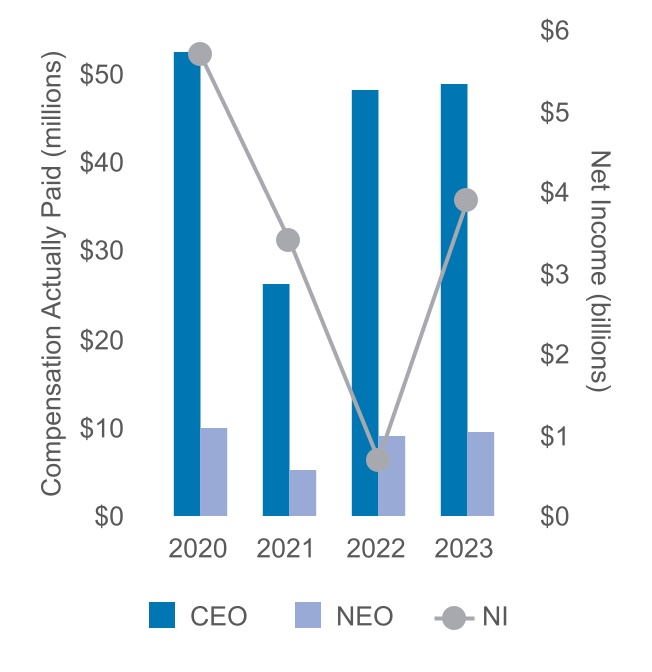
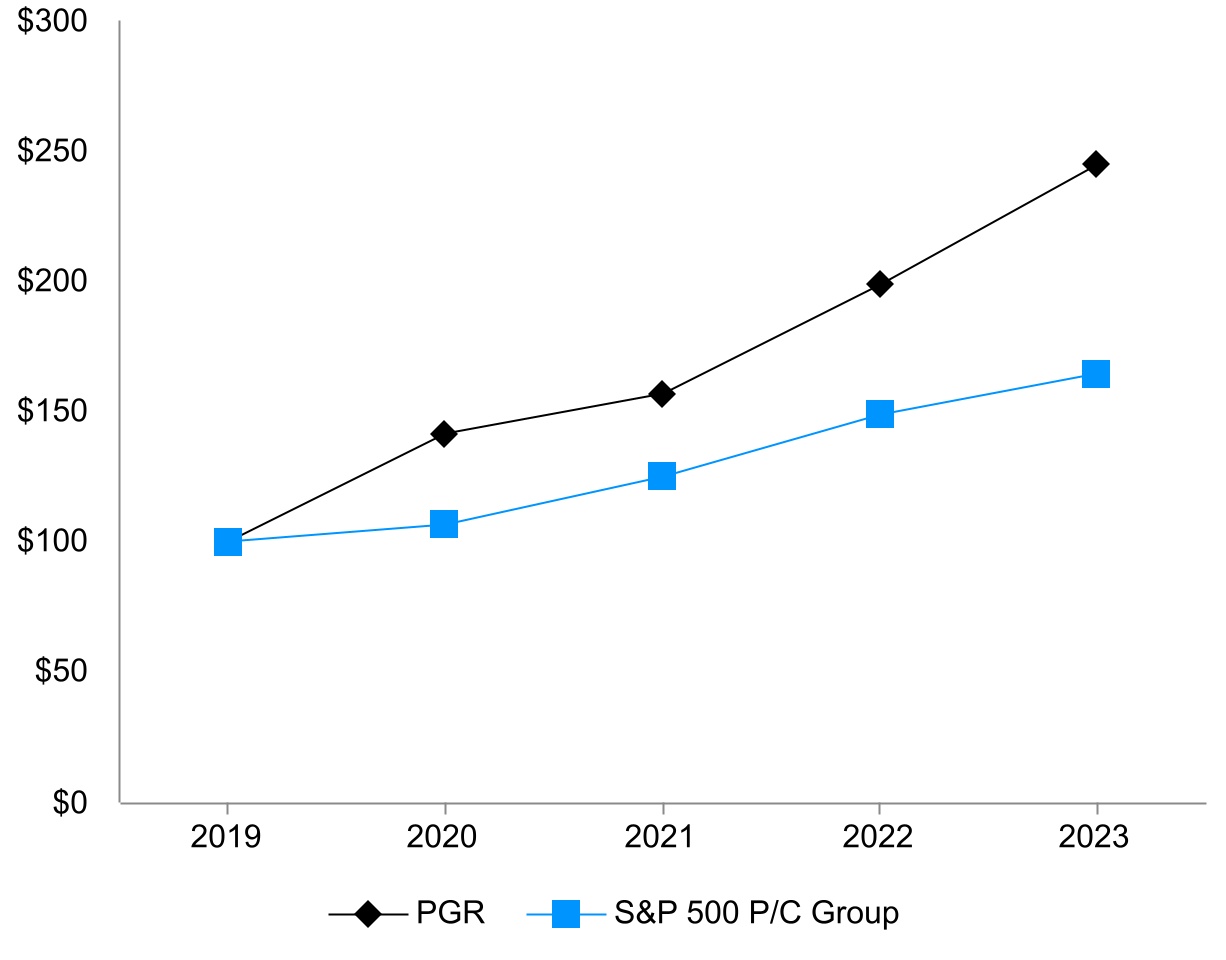
| Name | Combined Ratio | Premium Growth | 3-Year Return Fixed- Income Portfolio | Policies In Force (PIF) Growth | ||||||||||
| Susan Patricia Griffith | ✔ | ✔ | ✔ | ✔ | ||||||||||
| John P. Sauerland | ✔ | ✔ | ✔ | ✔ | ||||||||||
| Patrick K. Callahan | ✔ | ✔ | ✔ | |||||||||||
| Karen B. Bailo | ✔ | ✔ | ✔ | |||||||||||
| John Murphy | ✔ | ✔ | ✔ | |||||||||||
| Program | Combined Ratio | Premium Growth | 3-Year Return Fixed- Income Portfolio | PIF Growth | ||||||||||
| Gainshare Program | ✔ | ✔ | ||||||||||||
| Performance-Based Restricted Stock Unit Awards (Growth in Market Share) | ✔ | ✔ | ||||||||||||
| Performance-Based Restricted Stock Unit Awards (Investment Results) | ✔ | |||||||||||||
| Name | Name | Fees Earned or Paid in Cash1 ($) | Stock Awards2 ($) | Total ($) | ||||||||||||||||||||||||||||||
| Name | ||||||||||||||||||||||||||||||||||
| Name | Fees Earned or Paid in Cash1 ($) | Stock Awards2 ($) | Total ($) | |||||||||||||||||||||||||||||||
| Danelle M. Barrett | ||||||||||||||||||||||||||||||||||
| Philip Bleser | Philip Bleser | $— | $280,072 | |||||||||||||||||||||||||||||||
| Stuart B. Burgdoerfer | Stuart B. Burgdoerfer | 110,000 | 165,028 | 275,028 | ||||||||||||||||||||||||||||||
| Pamela J. Craig | Pamela J. Craig | 116,000 | 174,015 | 290,015 | ||||||||||||||||||||||||||||||
| Charles A. Davis | Charles A. Davis | — | 290,024 | 290,024 | ||||||||||||||||||||||||||||||
| Roger N. Farah | Roger N. Farah | — | 305,027 | 305,027 | ||||||||||||||||||||||||||||||
| Lawton W. Fitt | Lawton W. Fitt | — | 470,055 | 470,055 | ||||||||||||||||||||||||||||||
Devin C. Johnson3 | 61,833 | 92,786 | 154,619 | |||||||||||||||||||||||||||||||
| Devin C. Johnson | ||||||||||||||||||||||||||||||||||
| Jeffrey D. Kelly | Jeffrey D. Kelly | 110,000 | 165,028 | 275,028 | ||||||||||||||||||||||||||||||
| Patrick H. Nettles, Ph.D. | — | 315,053 | 315,053 | |||||||||||||||||||||||||||||||
| Barbara R. Snyder | Barbara R. Snyder | — | 265,070 | 265,070 | ||||||||||||||||||||||||||||||
| Jan E. Tighe | 106,000 | 159,012 | 265,012 | |||||||||||||||||||||||||||||||
Jan E. Tighe3 | ||||||||||||||||||||||||||||||||||
| Kahina Van Dyke | Kahina Van Dyke | — | 265,070 | 265,070 | ||||||||||||||||||||||||||||||
| Chairperson of the Board | $ | 485,000 | |||
| Non-Employee Director | 300,000 | ||||
| Additional compensation for Committee Chair: | |||||
| Audit Committee | |||||
| Investment and Capital Committee | |||||
Nominating and Governance Committee | 20,000 | ||||
| Technology Committee | 25,000 | ||||
| Other additional compensation: | |||||
| 10,000 | |||||
Secondary Committee assignment | 15,000 | ||||
| EQUITY COMPENSATION PLAN INFORMATION | |||||||||||||||||
| Plan Category | Number of Securities to be Issued upon Exercise of Outstanding Options, Warrants and Rights | Weighted-Average Exercise Price of Outstanding Options, Warrants and Rights | Number of Securities Remaining Available for Future Issuance Under Equity Compensation Plans 1 | ||||||||||||||
| Equity compensation plans approved by security holders | |||||||||||||||||
Employee Plans: | |||||||||||||||||
| 2015 Equity Incentive Plan | 2,893,743 | 2 | NA | 5,185,949 | 3 | ||||||||||||
Director Plans: | |||||||||||||||||
| Amended and Restated 2017 Directors Equity Incentive Plan | 25,075 | NA | 392,436 | 4 | |||||||||||||
| Equity compensation plans not approved by security holders | |||||||||||||||||
| None | |||||||||||||||||
| Total | 2,918,818 | NA | 5,578,385 | ||||||||||||||
| The Board of Directors recommends that you vote FOR this proposal. | ||||||||||||||
| The Board of Directors recommends that you vote FOR this proposal. | ||||||||||||||
| The Board of Directors recommends that you vote FOR this proposal. | ||||||||||||||
| Fees | Fees | 2020 | 2019 | Fees | 2023 | 2022 | ||||||||||
| Audit | Audit | $ | 4,199,821 | $ | 4,133,878 | |||||||||||
| Audit-Related | 639,825 | 0 | ||||||||||||||
| Audit-related | ||||||||||||||||
| Tax | Tax | 26,393 | 40,702 | |||||||||||||
| Other | Other | 91,040 | 0 | |||||||||||||
| Total | Total | $ | 4,957,079 | $ | 4,174,580 | |||||||||||
Report to Shareholders on Risks Created by the Company's Diversity, Equity, and Inclusion Efforts WHEREAS: The US Supreme Court ruled in SFFA v. Harvard on June 29, 2023, that discriminating on the basis of race in college admissions violates the equal protection clause of the 14th Amendment.1 Attorneys General of 13 States warned Fortune 100 companies on July 13, 2023, that SFFA implicated corporate diversity, equity, and inclusion (DEI) programs.2 Prior legal advice regarding the legality of racially discriminatory programs has been called into question post-SFFA.3 Recent analysis of American Fortune 100 hiring in the wake of the 2020 race riots found that whites were excluded from 94% of the hiring decisions,4 a statistic that itself provides prima facie proof of illegal discrimination on the basis of race by these companies, given that whites constitute 76% of the American population.5 A review of Progressive's website on Nov. 21, 2023, revealed that Progressive has possibly implemented illegal racial quotas by (1) setting "an ambitious goal to double the representation of people of color in senior leadership from 10% to 20% by the end of 2025,"6 and (2) implementing hiring practices resulting in 21 percent of Progressive employees being Black even though Blacks only make up 12 percent of the U.S. population, which may explain why Asians and "LatinX" employees are underrepresented.7 The foregoing may partly explain why a 2022 article in Insurance Business ran under a headline that read in part: "Progressive slammed for 'woke' hiring practices."8 RESOLVED: Shareholders ask that the board commission and publish a report on (1) whether the Company engages in any practices directly or indirectly associated with diversity, equity, and inclusion (DEI) initiatives that may create risks of discriminating illegally on bases such as race and sex, thereby potentially triggering justice-seeking responses from stakeholders of the company (including employees, suppliers, contractors, and retained professionals), and (2) the potential costs of such discrimination to the business. SUPPORTING STATEMENT: In just the past year, a corporation was successfully sued for a single case of discrimination against a white employee resulting in an award of more than $25 million.9 The risk of being sued for such discrimination appears only to be rising.10 With over 50,000 employees,11 Progressive likely has at least 37,000 employees who are potentially the victims of this type of illegal discrimination because they are white, Asian, male, or straight.12 Accordingly, even if only 10 percent of such employees were to file suit, and only 10 percent of those prove successful, the cost to the company could exceed $9 billion. And while racial equity audits can cost up to $4 million, this report should cost much less, as it need review only the potentially discriminatory programs, unless Progressive has established so many such programs that its liability for this discrimination must be expected to be much higher. | ||
1 https://www.scotusblog.com/case-files/cases/students-for-fair-admissions-inc-v-president-fellows-of-harvard-college/ 2https://ag.ks.gov/docs/default-source/documents/corporate-racial-discrimination-multistate-letter.pdf?sfvrsn=968abc1a_2 3 https://freebeacon.com/democrats/starbucks-hired-eric-holder-to-conduct-a-civil-rights-audit-the-policies-he-blessed-got-the-coffee-maker-sued/ 4https://www.bloomberg.com/graphics/2023-black-lives-matter-equal-opportunity-corporate-diversity/ https://www.dailywire.com/news/bloomberg-flubs-data-for-bombshell-report-that-only-6-of-new-corporate-hires-are-white 5https://www.census.gov/quickfacts/fact/table/US/PST045222 6https://www.progressive.com/about/diversity-and-inclusion/ 7 Id. 8https://www.insurancebusinessmag.com/us/news/breaking-news/ceo-steps-in-as-progressive-slammed-for-woke-hiring-practices-406351.aspx 9https://www.foxbusiness.com/features/starbucks-manager-shannon-phillips-wins-25-million-lawsuit-fired-white-donte-robinson-rashon-nelson 10 See, e.g., https://aflegal.org/america-first-legal-files-class-action-lawsuit-against-progressive-insurance-for-illegal-racial-discrimination/; https://aflegal.org/afl-files-federal-civil-rights-complaint-against-activision-for-illegal-racist-sexist-and-discriminatory-hiring-practices-and-sends-letter-to-activision-board-demanding-they-end-unlawful-dei-polici/; https://aflegal.org/america-first-legal-files-federal-civil-rights-complaint-against-kelloggs-warns-management-that-its-violating-fiduciary-duties/ 11https://www.progressive.com/careers/ 12https://www.census.gov/quickfacts/fact/table/US/PST045222 | ||
| For the reasons described above, the Board believes the requested report is unnecessary, would be a poor use of the Company’s resources, and would not be in the best interests of the Company or its shareholders. Therefore, the Board recommends that you vote AGAINST this proposal. | ||
| If you vote online or by telephone, you do not have to return your proxy card or voting instruction form. | ||||||||||||||
| Item Number | Proposal | Board Recommendation | Affirmative Vote Required for Approval1 | Broker Discretionary Voting Allowed?2 | ||||||||||||||||||||||||||||
| 1 | Elect as directors the 12 nominees identified in this Proxy Statement, each to serve for a term of one year | FOR each nominee | Majority of votes cast | No | ||||||||||||||||||||||||||||
| 2 | Approve The Progressive Corporation 2024 Equity Incentive Plan | FOR | Majority of votes cast | No | ||||||||||||||||||||||||||||
| 3 | Cast an advisory vote to approve our executive compensation program | FOR | Majority of votes cast | No | ||||||||||||||||||||||||||||
| Ratify the appointment of PricewaterhouseCoopers LLP as our independent registered public accounting firm for | FOR | Majority of votes cast | Yes | |||||||||||||||||||||||||||||
| 5 | Act on a shareholder proposal, if properly presented | AGAINST | Majority of votes cast | No | ||||||||||||||||||||||||||||




